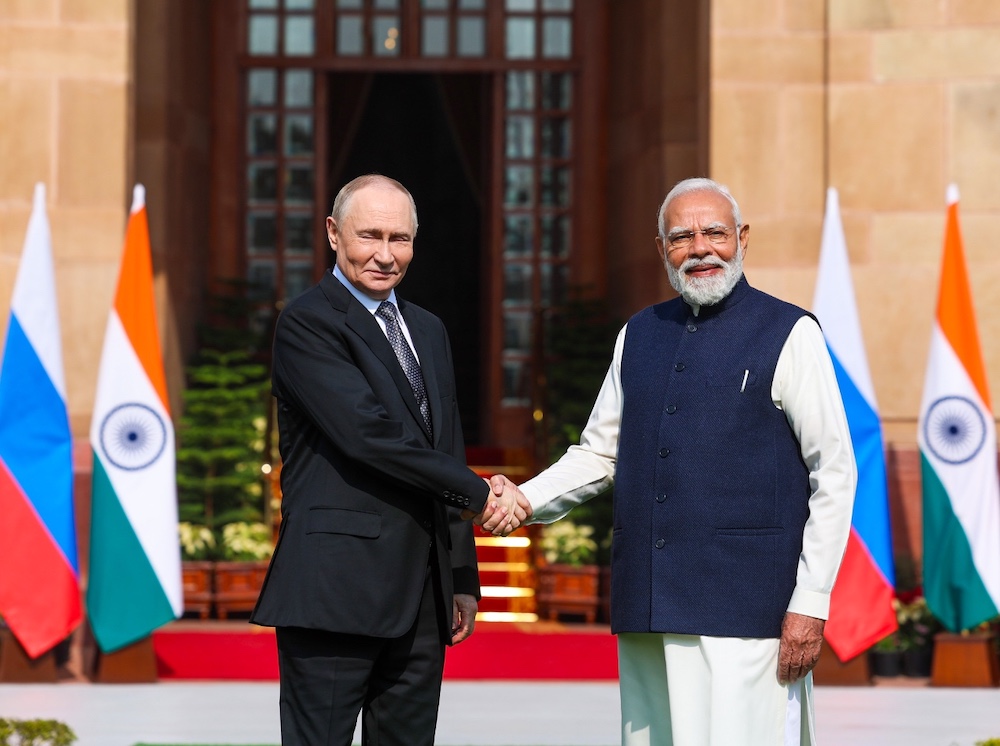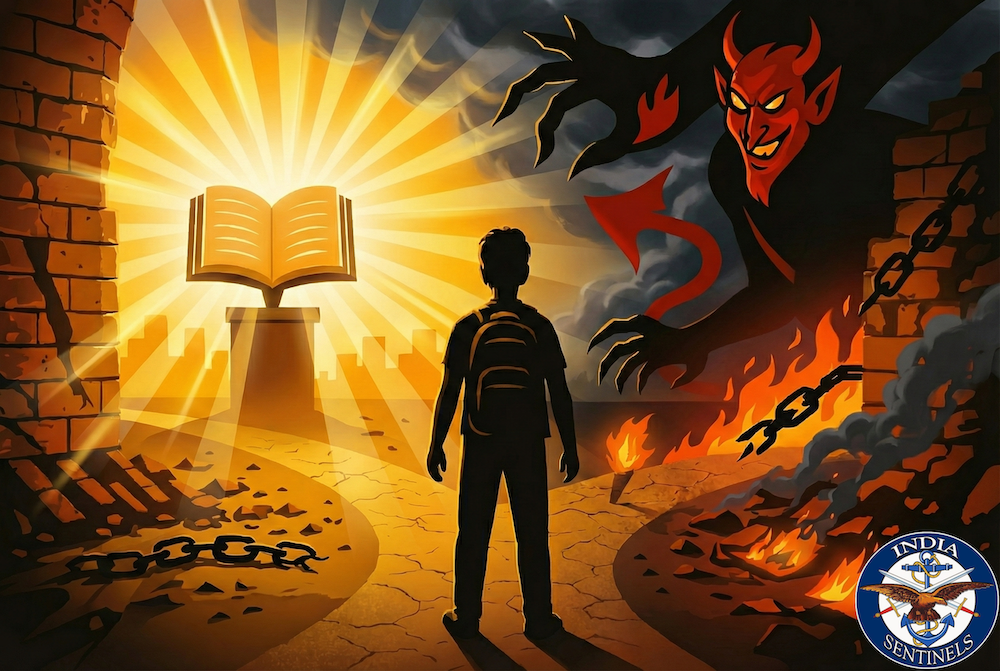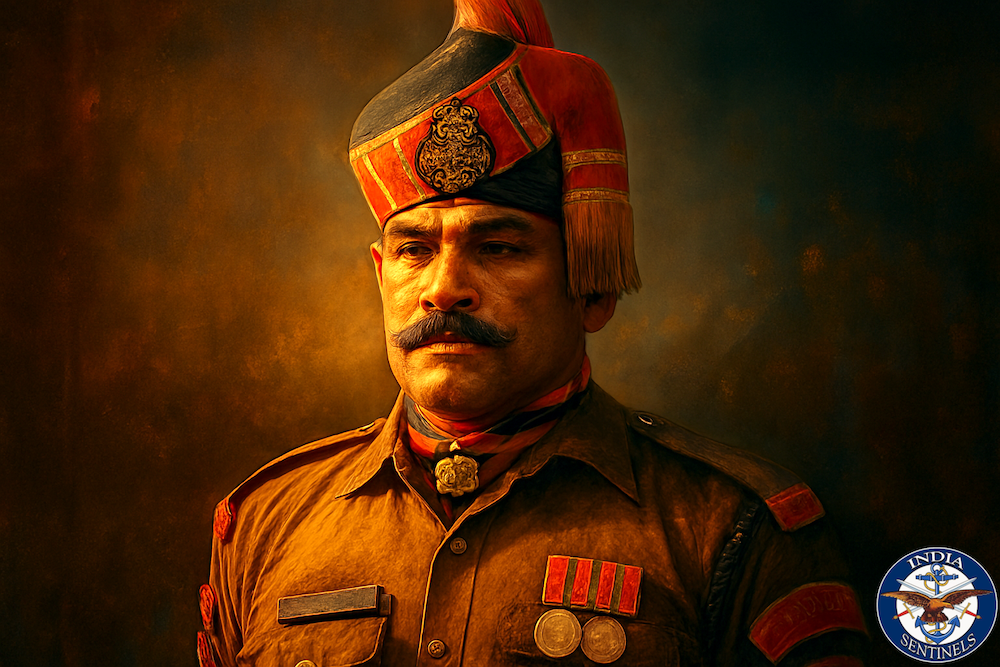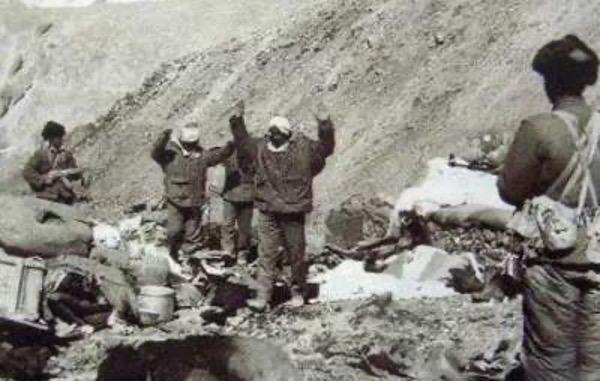 Indian troops surrendering at the Namka-chu area.
Indian troops surrendering at the Namka-chu area.
This is part of the series on the 1962 India-China border war that seeks to debunk the myths, misinformation and politics spun around India’s debacle in the North-East Frontier Agency.
Generations of Indians have grown up internalizing a standard narrative on the 1962 border war between India and China. India lost a huge chunk of its land that it had historically held to the Chinese, due to a political and military disaster. And this was brought on by the unspeakable blunders of the-then prime minister, Jawaharlal Nehru, and his defence minister, Krishna Menon.
According to the conceptions, some of their blunders included:
- Nehru’s weakness towards China and “appeasement” of the Chinese.
- His neglect of the Indian military.
- His preference for “incompetent sycophants”, like Lieutenant General Brij Mohan Kaul, a fellow Kashmiri pandit, after ignoring “legendary professionals”, like General Kodendera Subayya Thimmayya and his “rightful successor” Lieutenant General Shankarrao Pandurang Patil Thorat. Apart from Kaul, General Pran Nath Thapar, Brigadier DK “Monty” Palit and Lieutenant General Lionel Protip “Bogey” Sen were also supposed to be “incompetent officers” who were patronized by Nehru and Menon.
- The so-called suicidal and much-maligned “Forward Policy”, whereby Indian posts were pushed forward aggressively, with no tactical considerations, purely for the show of flag – a politician’s folly.
- The government’s interference in purely military decisions that led to ultimate disaster.
Has any of our readers heard anything outside the contours of the points stated above? These do capture the essence and flavour of the story of our 1962 China debacle, right?
So now come let’s examine each of these, keeping aside opinions or predispositions, in the light of documented facts and events, rather than hearsay, innuendos, and personal anecdotes. Given the vast scope of the subject, we will limit our focus on the following:
- The personality-based blame game.
- Documented policies, statements and memoirs related to relevant policies, decisions, and pronouncements of these “personalities”.
- Military orders, instructions, reports, recommendations, and decisions.
- Key episodes, battles and defeats which have attained iconic status.
- Research work on various aspects of the India-China conflict and related matters by scholars.
Our scope of study and analysis will exclude the widely known and elaborately described details of the actual battles unless those have a direct bearing on the themes and findings of our study. There are, in fact, excellent published accounts from officers who have fought in those actions. The likes of, then 7 Brigade commander, Brigadier John Dalvi[M1], then CO of 4 Division Signals, Major General KK Tiwari[M2] and then gun position officer (GPO), E Troop, 17 Para Field Regiment (deployed on Tsangdhar ridge) Brigadier AJS Behl[M3].
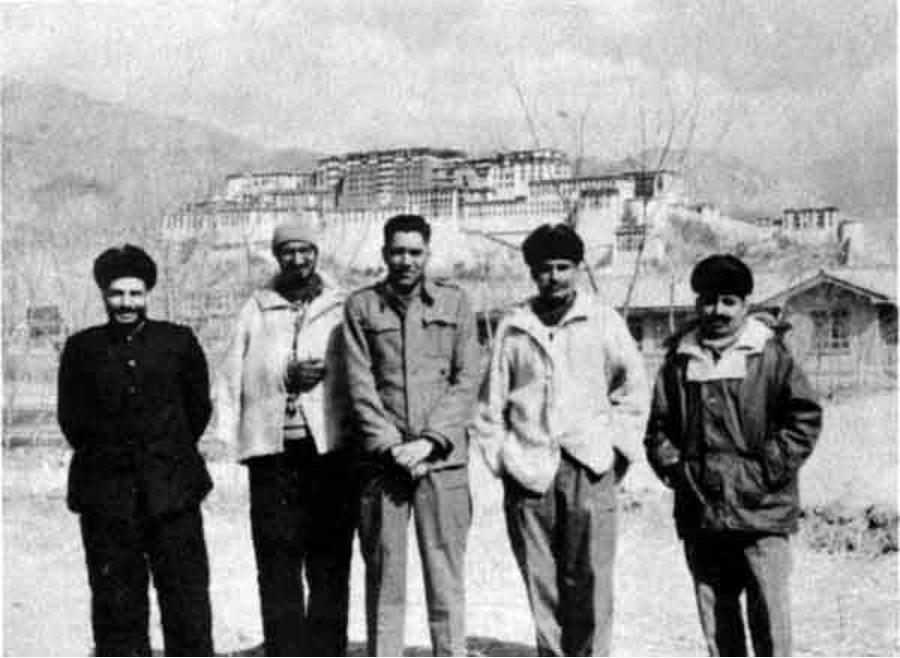 From left to right: Lt Col Rattan Singh, Lt Col BS Alhuwalia, Brig John Dalvi, Lt Col MS Rikh and Lt Col KK Tewari as PoWs in Lhasa.
From left to right: Lt Col Rattan Singh, Lt Col BS Alhuwalia, Brig John Dalvi, Lt Col MS Rikh and Lt Col KK Tewari as PoWs in Lhasa.
Therefore, if any reader wants to get a feel of what the actual action was like, in short a “war story”, then no armchair analyst can bring them a better and truer feel than the above officers, who fought in it.
Was Nehru and the Indian leadership ‘soft’ on China?
Let us give a wide berth to Indian political lore and partisan commentaries on this subject and look at the facts as presented by international scholars[R1–9].
Our reading is that the Chinese, and particularly China’s chairman, Mao Zedong, himself, were always deeply suspicious of Nehru personally due to his “elite class” background. To doctrinaire Marxists, the “class” aspect is the fundamental prism through which the world is viewed. Nehru was considered a “reactionary” dictated to by the Indian and western, big bourgeoisie. All his actions, attitudes and pronouncements on Tibet and China were viewed through this filter. Finally, the real casus belli for the war were the conviction among Chairman Mao and the Chinese leadership that Nehru had designs on Tibet.
Nehru viewed China as a huge landmass of fellow Asians, which had been tormented and exploited for long by imperialists. Hence, he perceived a commonality of interest between India and China in the early days. However, from 1949 onwards his perspective on China was pragmatic rather than “sentimental”. The way he saw it, the People’s Republic of China, as a large neighbour, wasn’t going any place else. They are here to stay, and we might as well accept them and coexist on a friendly basis, to mutual benefit.
Taiwan was a tiny footnote to the Chinese story in real terms, irrespective of the ideological intransigence of the US over the issue. All the talk of “Hindi-Chini Bhai Bhai” (India-China are brothers) is akin to the “biryani and hugging” bonhomie one has seen with our western neighbour from time to time, but practiced on a larger, institutional scale.
On Tibet, Nehru knew and understood the legacy of China’s suzerainty over Tibet since ancient times. He also recognized the reality of Tibet’s autonomous and special status within the larger reality of China’s sovereign rights. He tried to marry India’s special historical and “sentimental” relationship with Tibet with the “special and autonomous” aspect of Tibet’s status within the People’s Republic of China.
John Garver quoting from Claude Arpi and Tsering Shakya, encapsulates Nehru’s approach beautifully:
“Nehru envisioned a compromise between Chinese and Indian interests regarding Tibet, with Chinese respect for Tibetan autonomy combined with Indian respect for Chinese sovereignty over Tibet. This accommodation would, Nehru believed, provide a basis for a broad programme of cooperation between China and India on behalf of the peoples of the developing countries and against the insanity of a nuclear-armed bipolar Cold War. Nehru believed that by demonstrating India’s acceptance of China’s ownership and military control of Tibet while simultaneously befriending China on such issues as war in Korea, the PRC’s UN admission, the peace treaty with Japan and transfer of Taiwan to the PRC, Indochina, and decolonization and the Afro-Asian movement, China could be won to cooperation with India. The two leading Asian powers would then create a new axis in world politics. In terms of Tibet, Nehru hoped that China would repay India’s friendship and consolidate the Sino-Indian partnership by granting Tibet a significant degree of autonomy.”
However, China’s increasing interference in and coercive overlordship on Tibet disappointed Nehru deeply. This is where his schism with the Chinese Communist Party leadership began. And China’s later distrust and paranoia over the border issue, emanated from their leadership’s deep resentment over Nehru’s stance on Tibet. Mao read Nehru’s intentions towards Tibet as the quest for a buffer state between India and China. He saw Nehru’s actions through the pedantic Marxist paradigm of class sympathy for the “serf-owning oppressors” of the Dalai Lama’s genre.
The Chinese leadership was infuriated that Nehru was apparently not recognizing China’s absolute suzerainty over Tibet. According to them, Nehru was continuously diluting China’s authority in Tibet through all the talk of autonomy and special status. Apart from Nehru’s purported actions in encouraging reactionary and “anti-progressive” sections of Tibet’s Buddhist theocracy.
Ironically the-then Chinese premier, Zhou En Lai, had previously agreed with Nehru on the historically autonomous legacy of Tibet within the PRC.
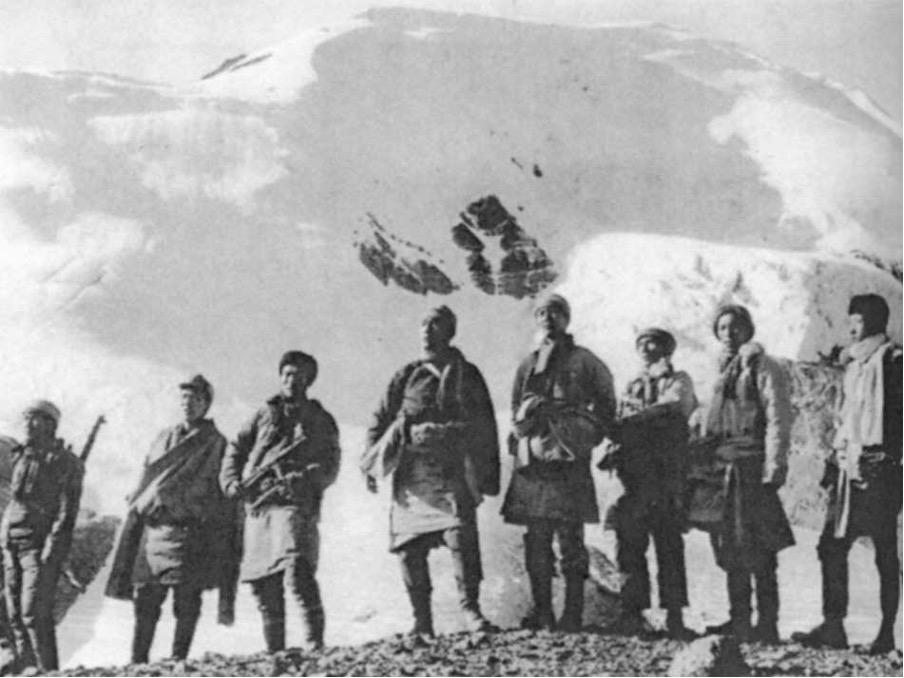 Resistance fighters on the Tibetan border during the early years of the CIA’s Tibet programme. (Photo courtesy: Lhamo Tsering’s collection.)
Resistance fighters on the Tibetan border during the early years of the CIA’s Tibet programme. (Photo courtesy: Lhamo Tsering’s collection.)
To this was added the aspect of the Tibetan insurgency and India’s role in it. For all the talk of passive and non-violent Tibetan resistance, which was publicly professed by Nehru, he was in the know about, and condoned, the United States’ Central Intelligence Agency’s campaign of subversion and armed insurrection in Tibet. Here, the Indian intelligence agencies covered its tracks very well. In period pieces, written around that time, no author or analyst could prove India’s role in armed Tibetan resistance. However, research into CIA’s archives and sources[R10] show that the Indian intelligence agencies supported the CIA’s efforts actively.
Did Nehru neglect the Indian military?
India was just getting on its feet after the widespread bloodshed and displacement that happened during Partition and the first Kashmir war. The country was plagued with a plethora of socio-economic problems. Indigenous capital formation was low. There was a multitude of vital sectors crying for investment and outlay of funds. Big powers were lying in wait to incorporate India into the armed camps of the Cold War. Under those circumstances, peaceful nation building was the way to go.
India’s defence spending was low until 1960, as the below graph illustrates. India was surrounded by poor and unsettled neighbours, as we were. Any serious military threat that could go beyond border clashes, was not on the radar.
However, as the graph below shows, 1962 (when the Forward Policy was in place) changed all that. Nehru’s defence budget for 1962 was 2.75% of GDP.
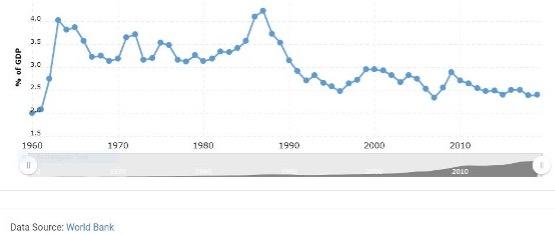
Just for the context, India’s defence budget for 2018 and 2019 were 2.38% and 2.40% respectively. The current fiscal’s figure standing at 2.45%. And for additional perspective, in the 3rd Plan (1961-66), the total allocation for the health sector was 2.9% of the total planned expenditure. Yes, India was a poor, newly independent, and a “third world” nation then. Therefore, it is difficult to substantiate the proposition that Nehru’s India “neglected” its military and threw it to the wolves wantonly.
So, how did we use and leverage those modest funds spent on defence, in 1962. Analysing this, we would, sadly, find that Nehru expected many times more from the military than what he could invest in it – for many years. And this obtuse refusal on this part, to engage with realpolitik, brought the most bitter of all defeats conceivable, personally to him, towards the end of his life and career.
Preference for ‘sycophants’ at the cost of ‘competent’ officers?
Let us study in brief and compare the credentials of the officers involved in this game of “deserving vs favourites”.
Thorat, the officer who is said to have been the right choice as Thimmayya’s successor, passed from the Royal Military College, Sandhurst in August 1926. He did his stint in the Staff College, Quetta. He saw extensive combat against the Japanese, first in the Naga Hills and Imphal sector and then in the re-conquest of Burma.
After arriving at the front in 1944 and getting temporary command of a unit (9/14 Punjab), Thorat faced raised eyebrows from Brigadier DAL Mackenzie for personally accompanying the rifle companies on a long recce mission. Again, in Burma’s Kangaw sector, in January 1945, this time as CO of 2/2 Punjab, after taking heavy casualties in a frontal attack, the 39-year-old Thorat joined his forward troops in hand-to-hand combat at Hill 170, snatched the sword of a much younger Japanese officer and slayed him on the way up.
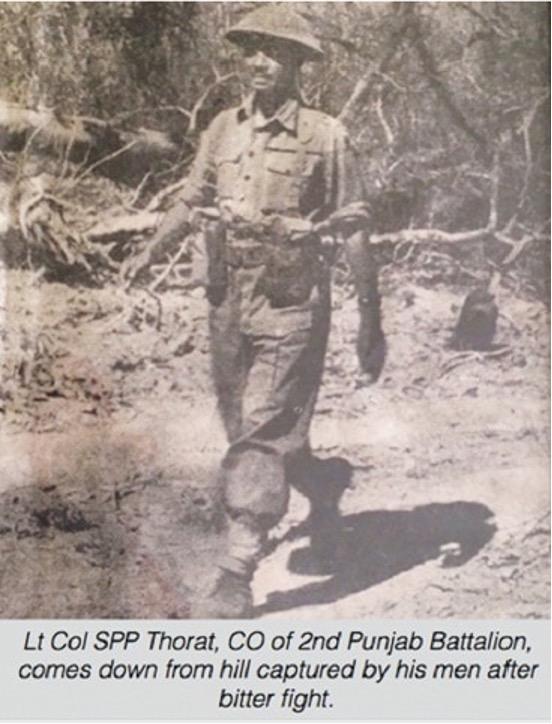 (Photo courtesy Dr YSP Thorat, son of Lt Gen SPP Thorat.)
(Photo courtesy Dr YSP Thorat, son of Lt Gen SPP Thorat.)
And what about the “sycophant” officers who get compared to him, like Thapar, who was made the Army chief instead of Thorat and the Eastern Army (Eastern Command) commander Sen?
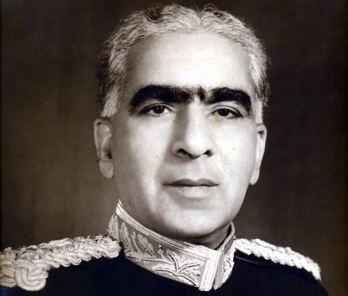 Gen PN Thapar.
Gen PN Thapar.
General Thapar, the much-maligned Army chief to actually succeed Thimmayya, was also an alumnus of Sandhurst, who passed out from the prestigious military academy in February 1926, as the latter’s batchmate. And in addition to Staff College, Quetta, he had attended the true-blue senior Staff College, Camberley too.
Gen Thapar was a brigade major with the 8th Army in the Middle East and Italy in the World War II, along with other staff positions, “managing” the combat forces, which included British units in the brigade. As an Indian, how much more military “glamour” do you want in the British Indian Army?
If you grind on the “effectiveness” and “combat record” over seniority, then how about General (later Field Marshal) Sam Hormusji Framji Jamshedji Manekshaw becoming the Army chief in 1969, based on “seniority”, rather than Lieutenant General Harbaksh Singh, the war hero of Tithwal (who won his Vir Chakra in the 1948 war in Kashmir), and the “saviour” of Punjab in the India-Pakistan war of 1965? Sam won the 1971 war. But who knew that in 1969?
Now let’s come to “Bogey” Sen, the much-talked-about commander of the Eastern Army in 1962. He too was commissioned from Sandhurst, in August 1931. He too served in the 51 Indian Infantry Brigade in Burma (as CO of 16/10 Baloch) along with Thimmayya and Thorat. Incidentally, this brigade was nicknamed the “Indian Brigade” since all its three battalions were Indian and commanded by Indian officers (Thimmayya, Thorat and Sen).
This was unique in the British Indian Army where the brigades had two Indian units with the third being British. And even the Indian battalions were mostly commanded by British officers. Coincidentally, all three of these Indian officers were awarded the DSO (Distinguished Service Order) for actions in the same area at the same time (Burma’s Arakan, near Kangaw, where, among other things, the famous battle for Hill 170, code named “MELROSE”, took place in January 1945.
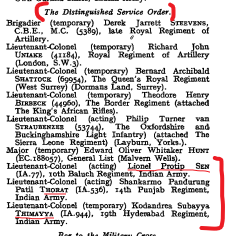 Supplement to the London Gazette, November 15, 1945.
Supplement to the London Gazette, November 15, 1945.
Sen won further laurels after Independence while commanding the 161 Brigade in the Kashmir valley, in the first India-Pakistan War. Remember those halcyon days of late 1947 when the fate of Jammu & Kashmir hung by a “slender thread” (in his own words)?
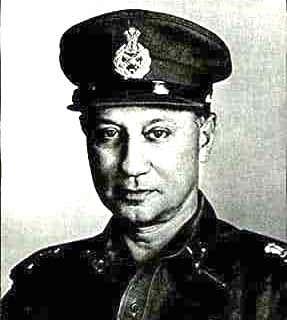 Lt Gen LP Sen.
Lt Gen LP Sen.
For Sen, it was Hill 170 all over again, but on a larger scale. He arrived during a command crisis. Lieutenant Colonel Dewan Ranjit Rai, CO of 1 Sikh (the first unit to arrive at Kashmir) had been killed in action, on October 28, the day after his arrival. Brigadier JC Katoch, commander of 161 Brigade, had been injured and evacuated on November 1, 1948. That was when Sen was summoned by the commander in chief of the Indian Army, General Sir Rob Lockhart, promoted as an acting Brigadier and ordered to fly to Srinagar and take over the brigade next morning.
Such was the rush that Sen borrowed the additional shoulder pips required for a brigadier’s uniform, from a staff officer and went to meet Lieutenant General Dudley Russell, the commander of the Delhi and East Punjab Command, for his briefing.
The British officer was frank and to the point. During his briefing of Sen, Russel said: “I am not allowed to enter the (Kashmir) valley. You will have to find your way about when you get there.”
The way Sen’s brigade fetched up in record time and pushed back the barbaric tribal militiamen from the doorsteps of Srinagar has remained an understated achievement in the annals of military history.
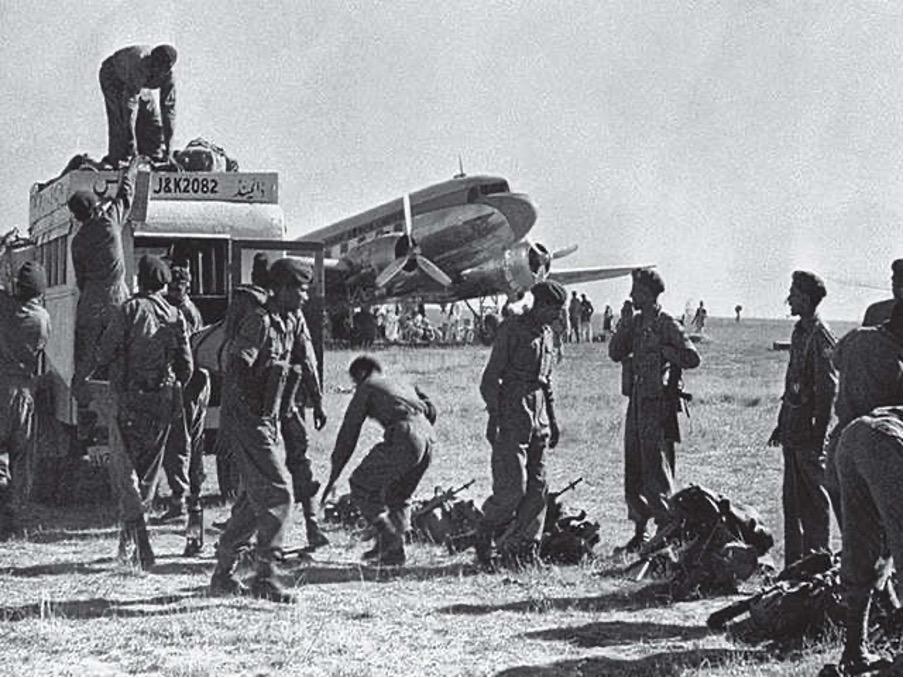 161 Brigade after arriving in Srinagar.
161 Brigade after arriving in Srinagar.
As an aside, since this article aims to dispel certain myths about the Indian military’s history, Sen received very “martial” and no-nonsense advice and blessings from two unlikely quarters before proceeding to his command.
Cursing Mahatma Gandhi, for his pacifism and “weakness” for the enemy, is favourite pastime of the Indian myth-making circles. On the same evening when he was given his promotion and his mission, Sen met Gandhi for his blessings. This is what Bapu told him: “Wars are a curse to humanity; they bring nothing but suffering and destruction. You’re going in to protect innocent people, and to save them from suffering and their property from destruction. To achieve that you must naturally make full use of every means at your disposal.”
The moral basis for India’s intervention in Kashmir couldn’t be better summed up than these words from a “pacifist”.
Similarly, the role of the British officers in the subcontinent has been severely castigated and dubbed “anti-India” during the J&K crisis. At the political level, the departing Raj admittedly played a shady role and some of their officers (like the ones with the Gilgit Scouts) played a dirty game. But Russell’s parting words to Sen couldn’t have been clearer and professional. He said, “The only advice that I can give you is that if you get a chance of hitting them, hit hard with all you have got and don’t let up.”
And now we come to an officer who is the “villain of the piece” for many.
The officer who is said to have almost singlehandedly caused the disaster in the North-East Frontier Agency (Nefa) – the redoubtable Kaul. Allegations of favouritism because of being Nehru’s kin, Menon’s “favourite”, like he was made the GOC of IV Corps (the formation that fought in Kameng – in the Namka-chu/Dho-la Post fiasco) just before the war, etc.
He is accused of many things.
Firstly, he was not from the combat arms, being an ASC (Army Supply Corps) officer. He was into politicking and influence peddling. Since he had the ear of Nehru and Menon, he wielded influence disproportionate to his position, that is, his superiors in the Army were deferential to him.
He was accommodated as GOC of 4 Corps, in the Kameng sector since he supported the “asinine” Forward Policy and its inevitable denouement – the border war with China. And in that role, he was a disaster – directly responsible for the mayhem at Namka-chu.
Some say he was a coward and shirker too when the chips were down for “falling ill” while in the forward position, just before the action started and had to be evacuated to a Delhi hospital. Where he (conveniently) sat out the battle in his hospital bed.
In short, he is the perfect fall guy to carry the can, for the debacle in Nefa.
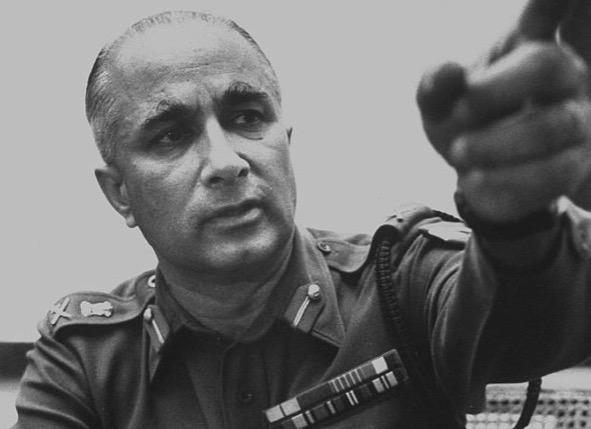 Lt Gen BM Kaul.
Lt Gen BM Kaul.
So before coming to Kaul’s role in the disaster at Namka-chu – the scene of the first episode in this tragedy – let us objectively scan his military record till then, sans the political commentary.
Kaul also passed out from Sandhurst. Over the years, after Independence, he became a kind of a “go-to man” for the Indian government, where special military situations were concerned. Kaul was always painfully aware that he hadn’t seen combat. And like many people with martial ambitions, without formal opportunities to make their bones in action, he went out of his way to seek out adventure and perilous situations. This, as we shall see, led to shallowness in faculties essential for a general staff officer, like operational appreciation in depth. His style and penchant throughout remained that of a swashbuckling, go-to man, seeking instant thrills.
During the Liberation of Goa, in December 1961, Kaul, then the CGS, with no call to physically participate in combat, insisted on joining the forward troops of 63 Brigade spearheading Operation Vijay. Accordingly, as soon as 3 Sikh crossed the border at 5.15am on December 17, on the “Yellow Route” en route Mollem, Kaul followed suit, in the company of Brigadier KS Dhillon.
This act of bravado was unnecessary for a chief of general staff and unheard of. His skills and presence were not relevant to front line combat operations here!
By the way, as the CGS of the Indian Army, Kaul’s planning and handling of logistics for this operation, were brilliant and execution superb.
However, his bravado and courage were not always misdirected. The year before Operation Vijay, he was assigned by Nehru and Menon to go and sort out a tricky situation in Nagaland. An IAF Dakota on a supply run to the isolated post at Purr, had been shot down by Naga insurgents and its crew taken captive. Kaul landed by helicopter in the insurgents’ territory with a rescue team and successfully retrieved the captives. Again, this was not, strictly speaking, a CGS’s job. Nonetheless, it was very impressive to behold.
Namka-chu valley – the ‘crime scene’
In view of the wide scope of our study, we are publishing this article in serial form. The first part below analyses the circumstances and reasons behind India’s military defeat in the western subsector (Kameng Frontier Division) of Nefa in the infamous battle of Namka-chu. The virtual destruction of Brig John Dalvi’s 7 Brigade (under Parshad’s 4 Division), in a few hours, is the most ignominious chapter in the military history of Independent India. However, like we said at the beginning, we would not get into the widely known details of the actual battle, which are easily available in published form, written by direct participants in that tragedy.
So let us begin by examining Kaul’s actual actions as GOC of IV Corps, in October 1962. The sequence, timing, substance, and impact of those actions.
Kaul, then the CGS, was called back from leave on October 3, 1962 and told about his new appointment as general officer commanding of IV Corps, by Thapar, the Army chief, at 9pm at the latter’s residence. He flew to Tezpur next day (October 4) and arrived in the afternoon. There he had a conference with Sen, who was the Eastern Army commander then, Lieutenant General Umrao Singh, GOC of XXXIII Corps (the new IV Corps command was carved out of the XXXIII Corps area).
The briefing Kaul received from his predecessor impressed him enough to promptly send a signal to the Eastern Army (whose commander he had just met) and Thapar that the Chinese intended to ambush the Indian Army in the Dhola-Tsangdhar sector with the intention of capturing Tawang.
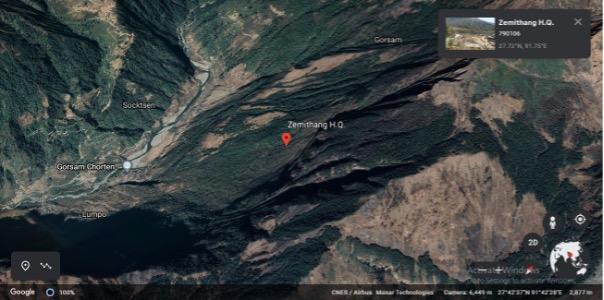
On October 5, 1962, Kaul flew to Darranga airstrip and took a helicopter to Zemithang ALG (advanced landing ground). There, he was briefed by a field intelligence asset about the ground situation and the Chinese strength. Kaul sent a signal to Eastern Command and AHQ to the effect:
- That the Chinese had at least a brigade concentrated in the Thag-la area already.
- The Chinese weapons in this area included artillery, heavy mortars, and recoilless guns.
- He could not (in view of our lean and their far superior resources) rule out the possibility of the enemy overwhelming our forces.
- Unless we retrieved this situation speedily, we might have a national disaster.
- Therefore, he recommended, as a precautionary measure, offensive air support to be positioned suitably without delay and made available to him at the shortest notice, if necessary.
At this stage, the dates and contents of Kaul’s signals to higher command are noteworthy. Do we see this far an officer blind to reality and misleading his superiors about the equation on the ground, as some have insinuated?
No.
Then again, this same officer, in his earlier avatar as CGS, had been deeply involved with the policies and decisions that led to the mess, which he now found himself in.
Kaul’s general staff’s opinions and appreciation of the strategic and operational situation, at that stage, is succinctly conveyed through a comment made by his officiating CGS, Major General JS Dhillon, a month earlier, in September, when he was on leave. Maj Gen Dhillon told the Eastern Army commander, Sen: “Experience in Ladakh had shown that a few rounds fired at the Chinese would cause them to run away.” (This was quoted in the official history of the 1962 war).
Therefore, how does the reader evaluate Kaul’s predicament? An essentially “go to” adventurer had been given the job of CGS (with political leanings factored in by the defence minister), which requires a very different set of aptitudes? That apart, what did Army Headquarters (AHQ) do about his signals which warned about dire consequences and a cataclysmic military outcome?
Some pointers to both these rhetorical questions lie in the curious goings on at AHQ, both at command and staff levels, in this one year, that led the Indian Army by the hand, to this situation at Namka-chu.
Nehru’s government gave a policy decision on the much-talked-about “Forward Policy” on November 2, 1961. From the Army’s side the chief, Thapar, was present. Given below is the operative part of the policy as laid out by the government. There are no records to establish whether Thapar presented his own AHQ’s annual intelligence review on China-Tibet, in 1959-60, which clearly stated that China’s People Liberation Army would militarily resist any attempts to seize territory already occupied by it. However, Point C below appears to have catered to the risk of confrontation. Therefore, the Army’s apprehensions may have been factored in.
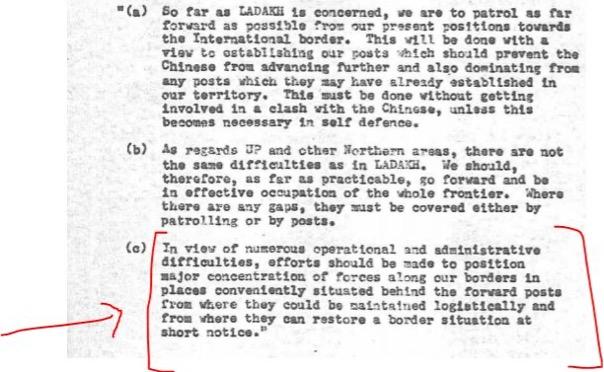 From Henderson Brooks Report.
From Henderson Brooks Report.
The Forward Policy, which was primarily meant for Ladakh, has been made out to be an irresponsible and frivolous monstrosity in ill-informed narratives that have been widely published and circulated. However, this document seems to be a cautious and balanced attempt to restore India’s rights of sovereignty over alienated chunks of territory, while being mindful of the military uncertainty inherent in such ventures. The Forward Policy’s application in Nefa’s, Kameng Frontier Division, has a different nuance vis a vis the situation in Ladakh. We shall examine that later in this story.
What is astounding is the action that the AHQ took (or didn’t take) while operationalizing this Forward Policy. After no visible action for a month after the above meeting, thereby losing precious time, AHQ released the following order, according to the HBR:
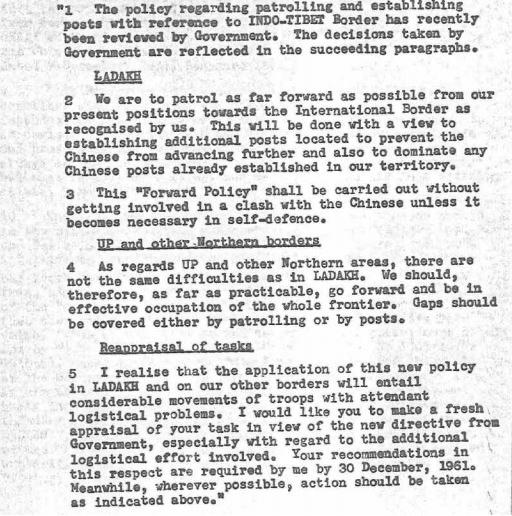
Conspicuous by its absence is the “Point C” of the original Forward Policy document issued on November 2. The AHQ, here makes no mention of any firm bases behind the forward posts, which would serve as logistic hubs and operational bases for the “major concentration of forces”, which were essential pre-requisites for operationalizing the original policy.
Therefore, as we can see, the AHQ is accountable for not only the deliberate emasculation of the military aspect of the Forward Policy but also for defiance against an enabling directive from the highest level.
It is obvious that Kaul’s general staff was fully in the know and had helped push forward the penny packets which constituted Army’s advanced posts without doing anything about the essential prerequisite, like the operational and logistic bases ordered to be put in place by the government.
Now let us see what Kaul did, when he himself landed in the mess that he had helped create.
On October 6, Kaul reached the Army’s forward positions at Bridge I (MM9114) on the Namka-chu (“chu” means “river” in Tibetan), across which the Chinese held their positions. He was the first Indian general to have reached this forward defended locality (FDL). This means, no one in the command hierarchy, above a brigadier, had any first-hand feel about this area, which had assumed such criticality in the rapidly deteriorating India-China relationship.
The local divisional commander (GOC of 4 Division), Major General Niranjan Parshad accompanied him.
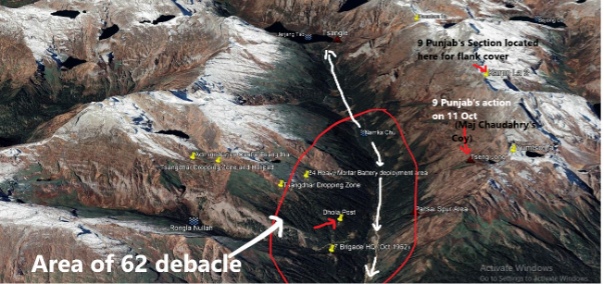
During his sojourn in the Namka-chu-Dhola Post area (details of this post and the operational zone it covered, given later) between October 6 and 10, Kaul sent a series of signals to AHQ and Eastern Command …
- On 7 October Kaul signalled AHQ and Eastern Army that (among other things) the bulk of the air-dropped supplies were landing in inaccessible places from where they couldn’t be retrieved.
- Rajput and 1/9 Gorkha had supplies for just 3 days, with 50 rounds of rifle ammo per man, mortars and ammunition being in transit from Lumpu (MM8906). Due to better resources, the Chinese were subsequently, likely to dislodge IA from any positions that may be gained initially.
Let us now note Kaul’s signal to AHQ and Eastern command on 10 October after the morning battle at Tseng Jong and Karpo-la-II, where the Delta Company of 9 Punjab was overwhelmed by a Chinese battalion. This attack was supposed to be the opening gambit of an ambitious operation to dislodge the PLA from Thag-la-MM8717 (which India now resolved to claim assertively as her own territory as per the “Watershed Principle”, seeking to redefine the McMahon Line) and occupy it. Military historian, Major General PJS Sandhu (retired) claims that the PLA let off the surviving Indians and allowed them to carry their 11 wounded and return to the Army’s lines while the Chinese themselves properly cremated the 6 dead Punjabis. Was this a token of goodwill and a conciliatory message (in keeping with the “safety valve” built into the 22-point charter given by General Luo Ruiqing (chief of staff of China’s Central Military Commission), to PLA forces in the western sector (Ladakh) – “Only if Indian forces advanced to within 50 meters of PLA positions and Chinese forces could not survive without self-defence, would PLA forces prepare for self-defence. If the enemy then withdrew, PLA forces would not seek to block that withdrawal)” – or was it to camouflage the Chinese plans for the all-out, no-quarters-given attack to come soon?
Kaul’s version is that the company was ordered back to Indian lines by 7 Brigade after the seriousness of the Chinese attack was seen.
A grave situation had developed, post the action at Tseng Jong, the PLA had deployed a division against the 7 Brigade and the threat to Tawang itself was now real. He suggested that he be allowed to visit AHQ in person for briefing and consultation at length. He believed that a wrong position had been chosen to fight. He had failed to arrange for supplies and logistic build up in time. The problems were deep seated and would persist. Thus, the whole campaign should be revisited.
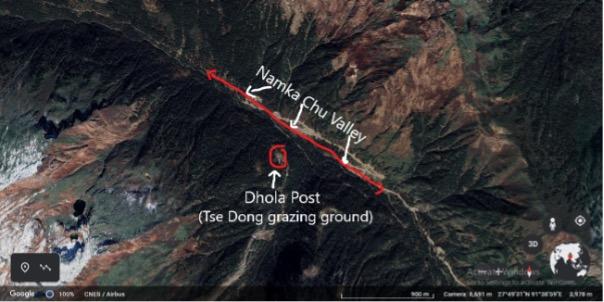
His request for a personal visit to Delhi was granted. He left for Delhi on October 11.
[Note: Before leaving, he ordered the GOC of 4 Division, Parshad, that all offensive plans were to be held in abeyance and the present line was to be defended. This order is to be noted and we will bring this up in our analysis, soon. Also, Kaul took his time, casually, and confirmed the above verbal order in writing on October 13, late in the day. For inexplicable reasons (other than a casual approach?) he did this after returning to his HQ at Tezpur, having spent two days with the Army top brass in Delhi, though the decision for holding the status quo, was endorsed at the highest levels, in the late evening of October 11.]
The order read:
- The bridges along Namka-chu from Bridge I (MM9114) to temporary log bridges (MM8317) will be held (in the south) at all costs.
- Line of communications via Lumpu (MM8906) will be protected.
- Hathung-la-MM8913 (south of Namka-chu) will be held.
- Tsangley-MM7719, will be held at the discretion of GOC, 4 Division.
It is contextual to this article, to point out that in the October 11 meeting at Delhi, where Kaul presented the grim reality at Namka-chu, Nehru asked Thapar and Sen for their views, they both agreed with the proposal to call of any offensive action and hold the present positions, but they didn’t favour any relocation of the Army’s defences to more convenient sites.
Please note that none of these officers had been physically anywhere near the theatre of action. Kaul’s belated visit to the Namka-chu valley offered the only first-hand peek at what the situation on the ground was. We don’t know whether the observations and analyses of the only officer who had studied and reported on the military-tactical possibilities of this theatre, Captain Mahabir Prasad of 1 Sikh, had been conveyed to these exalted quarters. But the bottom line is no relocation to better positions was sanctioned by IA’s top brass that day.
Nehru then said, “If the odds were against us and if the commander on the spot so felt, then instead of attacking the Chinese, we should hold on to our present positions.” [Emphasis ours.]
This runs contrary to the narrative of the political leadership imposing a suicidal course of action on the military, without reference to operational and tactical realities. It is clear that the Army’s military commanders at the highest levels didn’t want the 7 Brigade to be withdrawn from the exposed positions at Namka-chu for redeployment at a tactically and logistically more defensible location.
[Note: This was on October 11 – five days prior to the PLA’s internal report on Indian intentions at Namka-chu was submitted by General Lei Ying Fu to Mao and five days before Mao decided to destroy Indian forces in the Namka-chu area through an all-out offensive.]
This should be read along with Menon’s instructions after his September 22 meeting with Thapar, which read:
“… the chief of Army staff was accordingly directed to take action for the eviction of the Chinese from the Kameng Frontier Division in Nefa as soon as he is ready.” [Emphasis ours.]
No date or deadline was set for this action.
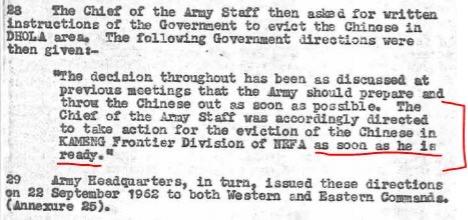 From Henderson Brooks Report.
From Henderson Brooks Report.
Therefore, the original political decision to evict the Chinese from Indian territory was made contingent upon military preparations and operational/tactical convenience as considered appropriate by Thapar. And it was Thapar who must bear the cross for the timing and operationalization of this order. More so since he, along with Sen and Kaul, knew that they had not made any provisions for creation of the logistic and operational bases in support of the forward staging areas, as had been originally instructed by the govt.
Is there a mitigating factor here for these three officers? Documents do show that AHQ had requested the government for resources to help ramp up the formations as per requirement. The government had not responded helpfully. Therefore, doesn’t that make the Forward Policy non-operational in essence? Did these officers and gentlemen stand their ground on this vital aspect?
As we can see, Kaul “made the bed on which he lay” in his brief sojourn at Namka-chu.
Here a parallel can be drawn with what happened a decade later regarding India Gandhi’s directions to Manekshaw about military operations in East Pakistan in 1971. In both instances the government of the day left it to the military to decide upon the timing and operational parameters of execution of political mandates. In the case of Namka-chu, this political mandate was revised within three weeks (on October 11, after Kaul’s briefing) upon advice of the military.
The new mandate of calling off the attack and holding the positions, didn’t go far enough to address the realities on the ground. But that again was according to the advice of the Army chief and the Eastern Army commander.
Did all accountability for this debacle lie only at the top?
Now, let us come to the curious matter of the Army’s imposition on and interference in political decisions, at lower levels, nearer to the ground. This makes for interesting reading, in the context of the so called “political interference” in military matters and the “irresponsible” Forward Policy being pushed by Nehru’s government.
Parshad is supposed to have mentioned to Kaul, during his visit in the forward areas that in early August, he had recommended the occupation of the tactically dominant Thag-la ridge (grid ref: 8717), which was our territory and free of the Chinese then.
A little background here would be in order. In June 1961, the Chinese seriously encroached upon India territory and patrolled inside Indian areas between three and four miles west of the Khinzemane Post (grid ref: MM9415) and adjoining grazing grounds, which India claimed. This post is a landmark because the Khinzemane route was taken by the Dalai Lama, ill and weak with dysentery, when escaping from the Chinese in Tibet, in 1959.
That was the point till which his Tibetan National Volunteer Defence Army escorts and the two CIA radio operators had accompanied him when he crossed over on March 31–April 1. This post remained disputed and a reference point for disputes and negotiations.
According to SIB (Subsidiary Intelligence Bureau) officer LD Kumar, India’s old border post at Khinzemane was 1.5 miles (2.4 kilometres) to the south of the new post and the Chinese officials had been persuaded by SIB people, with great difficulty to accept the location of the new post, by “pulling a fast one” about “maps” which they had “forgotten to bring”! (this was an excuse cooked up by Kumar to fend off the Chinese official for the moment).
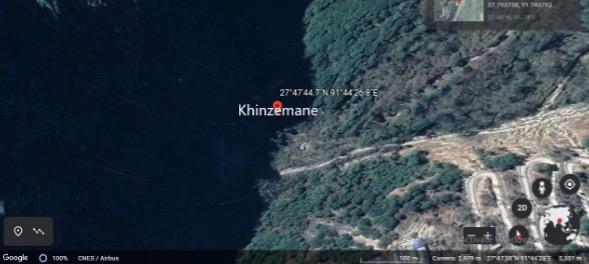 A closer look at the Khinzemane grazing grounds.
A closer look at the Khinzemane grazing grounds.
Like any sovereign nation that takes its borders seriously, Sen had asked the AHQ for permission to patrol this particular stretch of Indian territory, west of Khinzemane, near the McMahon Line, in the coming patrolling season. Accordingly, AHQ issued instructions on April 27 that patrolling could be done west of Khinzemane, up to the McMahon Line and posts could be set up near the trijunction of India-Bhutan-Tibet (grid ref: MM7914) without prior sanction. [Emphasis ours.]
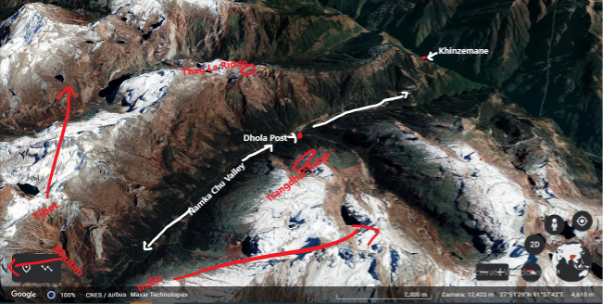
***
Mystery of Captain Mahabir Prasad’s patrol and the historical injustice done to him
It is while studying the execution of this AHQ order, that we find a series of interesting revelations, which hold the key to the subsequent debacle at Namka-chu.
When discussing the Namka-chu battle, all historical and military accounts talk about one Captain Mahabir Prasad[F2], Maha Vir Chakra, of 1 Sikh, who took a patrol to the Namka-chu area and set up the Dho-la post. Most analysts and narratives imply that Prasad erred in setting up the post at that location. The story goes that he gave precedence to issues of logistics and convenience in selecting the location rather than tactical considerations. All accounts agree that the Thag-la ridge, atop the slopes to the north of Namka-chu valley, was the best site for a post militarily.
History, until now, has blanked out the story of Prasad beyond this point in the narrative and mentions him as a footnote later when he fell in battle, on the morning of October 20.
First, let us hear what Brigadier Inderjeet Singh Gakhal (retired), who served in 1 Sikh where Prasad had served earlier during 1962, has to say and then let us us take a closer and more detailed look at the story of the valiant young officer.
On May 15, 1962, Prasad took a patrol consisting of the No. 4 platoon of 5 Assam Rifles, three intelligence men from the SIB (one officer plus two constables), a jawan from 1 Sikh and 150 porters from Lumpu (grid ref: MM8906) towards the Namka-chu area. After two days of trekking with the full team, on May 17, Prasad took the SIB officer, LD Kumar for a reconnaissance mission, ahead of the team, to locate a suitable location for the post, which had been ordered to be set up according to the AHQ’s order quoted above.
The two of them climbed up to the Tsangdhar ridge (MM8115) on the south side of the Namka-chu (river). According to the briefing received by Prasad, this was the area where the post was to be set up.
[Note: This will come up for analysis and we will discuss the responsibility and accountability.]
Prasad finally chose Tse-dong, (which he reported to be at grid ref: MM 8416) a small pasture, at 11,500–1,200 feet, on the slopes above Namka-chu, leading up to the Tsangdhar ridge, as the most suitable site for the post. This later came to be known as the “Dho-la post” and has been a subject of intense debate and scrutiny over the last 60 years.
However, he gave the same grid reference (MM8416) for the Bridge III over Namka-chu. Subsequently, as we shall see, XXXIII Corps quoted MM8316 as the actual grid reference for the post, whereas Prasad had used this reference (MM8316) for a hut 300 feet above the Dho-la post, which he had recommended as an OP (observation post). To confuse things further, in the report sent to the corps from the 4 Division, (presumably) the reference for the Dho-la post, was apparently given as MM8513 – as later mentioned by the corps to the Eastern Army and AHQ (this correspondence from XXXIII Corps, of August 1962, has been quoted later in this article).
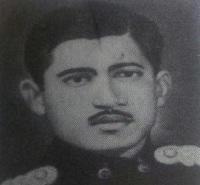 Capt Mahabir Prasad.
Capt Mahabir Prasad.
The word on the street is that Prasad was not even de-briefed when he returned after the long, 45-day patrol, although quoting him and mentioning his patrol are de rigueur in any story about Namka-chu.
More on this military hypocrisy later.
Thus confusion, misrepresentation, and a cavalier approach to critical matters, ran like a common thread through this entire Namka-chu-Dho-la post saga.
On May 18 and 19, Prasad continued with his patrolling of other features in the area. He climbed up the slopes to the north of Namka-chu and checked out Thag-la (MM8717), the much-talked-about tactical “magic feature”, which we didn’t occupy and, hence, the myth goes that we lost the battle at Namka-chu.
The route to Thag-la from Tse-dong (Dho-la post) was via a nine-mile-long track, crossing the Namka-chu (river), over the log bridge at MM8318. Then the track climbed steeply up the northern slope for 1,000 feet and turned east, following an easier gradient all the way up to Thag-la (pass). The one-way straight trek would take fit troops, travelling with normal packs, three hours. He returned to Tse-dong after patrolling the prominent features on the other side to evaluate the best location for the post.
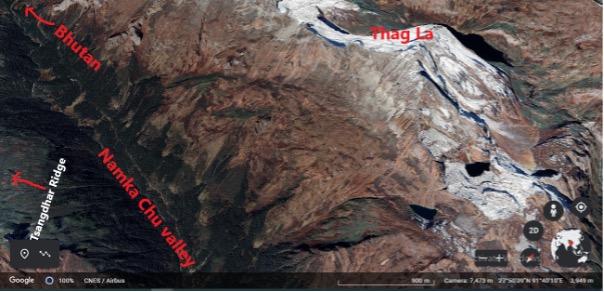
Upon his return to Tse-dong, and the gradual arrival of his team with building material and store stocks, work started on setting up the post, and was completed by June 4. Prasad continued to patrol other features all around the area, on both sides of Namka-chu between the India-Bhutan-Tibet trijunction.
[Note: The original map is MM7915 but claimed by Prasad to be at MM7522 and Khinzemane post to the east at MM9415.]
Here comes the crux of the issue.
Why was Thag-la not occupied? Why was the Dho-la post located at Tse-dong? What were the considerations? On whose orders was the post continued at that location (in spite of later claims from the Army’s top brass that it was neither legally in the clear nor tactically suitable)? What were the operational and tactical implications militarily? And most importantly, what were the political implications?
Let us start with the politics around it. Since the Indo-China border dispute is historically linked to “differing perceptions”, it is important to note that in the Nefa, the McMahon Line is a clearly drawn boundary, whose wisdom and methodology may be disputed on technical grounds, but not its location on the map. The Shimla Convention of 1914, between British India, the Tibetan government, and its sovereign overlord – the Republic of China, produced this boundary with clearly laid down coordinates.
Subsequently the Chinese government disputed that part of the agreement which dealt with the demarcation of the areas under the Tibetan government’s authority (the Blue Line) and those directly under Chinese administration (hence Ivan Chen, the Chinese representative didn’t sign the final agreement). However, the part demarcating the India-Tibet border (the Red Line, which is commonly known as the McMahon Line) over 890 kilometres from the northeastern extremity of Bhutan to the Isu-Razi pass on the Burma (now Myanmar) border, remained undisputed between the respective signatories – Henry McMahon, foreign secretary of British India and Lonchen Satra from the Tibetan side.
 From Henderson Brooks Report.
From Henderson Brooks Report.
Legally, the McMahon line is ironclad from the perspective of international law[R12]. However, both China and India kept disputing it on technicalities and then again quoting it, as per their convenience. India argued that the “spirit” of the Shimla Convention’s “inner line” – border between Tibet – and India as against the “outer line” – border between area controlled by Tibetan government and what came under direct Chinese administration – was based on the natural “watershed” features.
This passes over the Thag-la ridge, north of the Namka-chu valley and, hence, includes the Khinzemane grazing grounds, in the Niyamjang-chu valley (see the images above). Whereas the map signed off by the British and Tibetan representatives clearly shows the boundary starting from the trijunction between Bhutan, Tibet and India (as shown in the images above) and running across the Tsangdhar ridge, due east, for quite a bit.
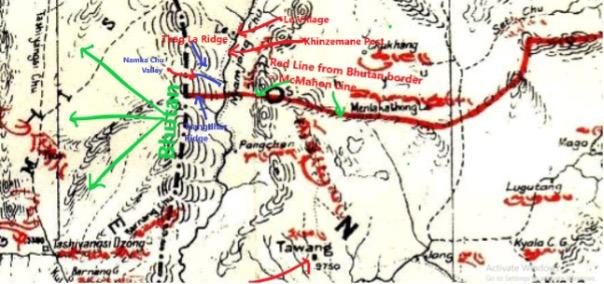 McMahon Line as plotted in the Simla Convention with our markings of relevant features.
McMahon Line as plotted in the Simla Convention with our markings of relevant features.
So, who has the right decide and act on these “ambiguities”? Is it for a nation’s military, at the subsector level (Kameng Frontier Division), to take it upon themselves, to change maps and boundaries? Who was authorized to sanction the infringement of the McMahon Line in the western subsector (Kameng) in Nefa?
Let us look at the political consequences of playing around with the McMahon Line in the Kameng Frontier Division.
Mao’s distrust and resentment towards Nehru, as we have repeatedly mentioned here, was deep-seated and intractable on grounds of “class” and ideology. His long-term plan to settle scores with Nehru’s India for its involvement with, and support to, the Tibetan rebels, was held in abeyance under situational constraints in 1959[R11].
Those constraints emanated from the state of China’s domestic economy as well as international pressures. The US, the Soviet Union and the fraternal enemy, Taiwan, were all hostile to Mao’s China in their own ways.
However, Mao was a chess player. He was waiting for India to push things beyond the threshold and bring it upon themselves. And that’s what India did, as per Mao’s paradigm, by staking claim, through military presence, to territories beyond the official McMahon Line, in the Namka-chu area.
It is to be noted that though China disputed the McMahon Line officially as the legitimate border, it was willing to live with it as an arrangement that allows conflicting parties to coexist peacefully, until a final settlement is reached. However, when the Army’s local military commanders crossed that disputed McMahon Line too and tried to reinterpret it on the ground, it was the proverbial last straw for Mao.
This was the casus belli for China’s military offensive in October 1962.
In June 1962, China’s ambassador to Poland, Wang Bingnan, was assured by the US Ambassador, Jacob D Beam, that America, under the present circumstances, would not support a Taiwanese attack on mainland China. In the meantime, the crisis in Laos too was capped by the big powers. And just as the situation at Namka-chu escalated through September and October, the Cuban missile crisis too was assuming dangerous dimensions.
The Soviet Union, on the backfoot on the Cuban crisis, needed solidarity within the “Communist Block”. Thus, there was no question of President Krushchev’s acting against China’s interests at that moment.
For the first time in years, China saw a window of opportunity in the east (Indian borders) where it could go for limited aggression without fear of a larger conflagration.
In the meantime, India had ample evidence of China’s sensitivity over Thag-la. The SIB team accompanying Prasad on one of his patrols to Thag-la, in May 1962, found a wooden board with a specific warning that this was Chinese territory. This coupled with the SIB team leader Kumar’s earlier experience with his Chinese counterpart over the Khinzemane post, which was a matter for serious consideration. But such political nuances were missed by the Army’s local commands with disastrous consequences.
 From Henderson Brooks Report.
From Henderson Brooks Report.
[Note: Here we must point out for those in today’s India, talking glibly about Indian border territories in Ladakh and Arunachal as “disputed areas”, this is what the Chinese “perception” of those disputed areas are.]
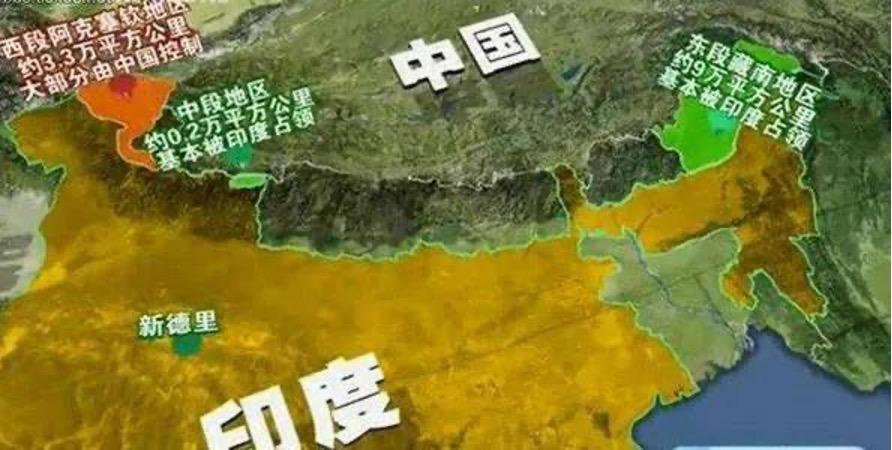 China claims portion marked in orange in Ladakh and marked green in Arunachal Pradesh.
China claims portion marked in orange in Ladakh and marked green in Arunachal Pradesh.
Now, let us come to the military and tactical considerations. Prasad’s assessment of the ground, from the perspective of a CDL (company-defended locality) was as discussed below:
The McMahon Line in the Namka-chu area and the approaches to Tawang (via Lumpu), in case of a Chinese attack, would be best defended by a platoon post at Tsangle, one at Hathung-la, with Company HQ plus 1 platoon at either Tse-dong (Dho-la post) or Thag-la. These posts would be mutually supporting, located at tactical hubs, and covering all the axes towards Lumpu (and further onto Zemithang-Shakti-Tawang).
His opinion was that the Dho-la post had the advantage of covering all the tracks from Namka-chu up the southern slopes; It was not easy to “creep up” on; It had an excellent view of the Thag-la (pass) which would be definitely used by the Chinese. It was much more easily maintainable than other comparable locations.
He found both Tsangdhar and Thag-la ridges to be covered in deep snow for many months and hence unsuitable for stable posts. Thag-la was also a much longer and difficult haul for porters, from Indian supply bases.
In case of full-blown war, Prasad was categorical that Tse-dong (Dho-la post) would be “suicidal” to fight in. It would be cut off and destroyed, he said, as it happened in the actual event. But then, in his opinion, Thag-la was also untenable as an FDL for more than 3 days. His thorough patrolling revealed that Thag-la would be easily cut off by enemy forces infiltrating through Karpo-la II and Namdang-la (MM7822).
[Have we ever heard of this last bit from any “authoritative” source or found any mention of this crucial fact in any standard narrative? As we shall see in this article, Thag-la became an obsession for the 4 Division, XXXIII Corps and subsequently both the Eastern Army and the AHQ. They made the primacy of Thag-la (and hence its occupation) a key proposition in their operational plans for this area. Through the decades, since the tragedy of Namka-chu, a binary proposition has been an essential part of the narrative: “Thag-la or nothing! Thag-la good, Dho-la bad (so very Orwellian, isn’t it?)”.]
However, it is to be noted that Prasad conceptualized a company-level operation at Namka-chu, on the Indian side. His entire assessment and prognosis were based on that scale. As it turned out within three months of his return from that area, it became the scene of a much larger operation, involving a brigade for India and the equivalent of a division for China. Obviously, the deployment plan and tactical factors would be different. But the fundamentals of terrain, topography, ordnance, and logistics would remain the same. Of particular interest here is the fact that it had taken 150 porters accompanying Prasad, in May, to carry material and supplies for the Dho-la post housing one Assam Rifles platoon. One can imagine the manpower needed to transport supplies for a four battalion-brigade.
Thus, the decision to air drop supplies on the Tsangdhar ridge. And given the realities of the terrain, the modest % of those supplies reaching the Indian forces.
Now, let us have a look at how these abovementioned factors played out in that area.
Both Tsangdhar and Thag-la ridges were difficult propositions for setting up a sustainable post.
The slopes below Tsangdhar rolling down to the Namka-chu valley, had thick vegetation and foliage, with soggy ground underfoot. Thus 2-inch mortars would be ineffective against an incoming menace. They would burst against overhead foliage and their impact would be dulled by the soggy ground.
All areas from the top of Tsangdhar ridge downwards (not the Dho-la post alone) were within medium-machine gun (MMG) and heavy-mortar range from the opposite slopes (rising up to Thag-la) across Namka-chu. Thus, reinforced bunkers and roofs were a must, wherever the post was put up. This factor cut both ways, so he recommended deployment of sufficient rifle grenades and grenade launchers in place of 2-inch mortars.
Even in those 24 days of Prasad’s stay in that area, since the post was put up by June 4, four mortar-proof bunkers had already been constructed, out of line of sight from Thag-la. Thus, in the 100-plus days after his leaving the post and the beginning of hostilities, how many more would have been constructed? According to him there was plenty of building material all around – solid timber.
[Note: By the way, the availability of food, from indigenous plants and leaves and local game were plentiful for foraging and hunting. This factor doesn’t find mention in the official lore about the miserable supply situation at Namka-chu.]
Prasad had recommended a section post (observation post) to be set up 300 feet above Tse-dong’s main platoon post. This was to obviate the possibility of being surprised by infiltration from across Namka-chu. His fall-back plan for tenability of Indian positions in case of war, was to occupy Thag-la or Karpo-la I, although Thag-la too was not tenable beyond three days. He also advised regular patrolling from Dho-la post to cover the features on the opposite side, Thag-la, etc.
Therefore, how did the PLA pull a surprise by pushing a battalion across Thag-la, on September 8, 1962, and surrounded the Dho-la post? A battalion can’t sneak up over and across the Thag-la feature in a such a way. They had obviously been planning it for a while.
[Note: Here, the nearest PLA post, until then, was at Le, six miles from Khinzemane, in the Niyamjung-chu valley. Therefore, obviously there was a major military lapse on that score. Anyway, the option of moving base to Thag-la then obviously got knocked out after the PLA rolled down from its slopes.]
Thus, it transpires that Army’s brigade and division commands didn’t ensure patrolling of the Thag-la and other passes, in the days leading up to the Chinese deployment there, despite no permission was required from higher commands. Neither did they ensure the following of basic security protocol laid down by Prasad for early detection of Chinese incursion through the features across Namka-chu. Therefore, the implication parroted down the decades, blaming Prasad’s setting up the post at Tse-dong, leaving Thag-la vacant doesn’t hold water. Since all the other conditions he had put down as non-negotiable for the post’s viability, were violated.
The plot further thickens as one goes deeper into the matter. In August 1962, after the Dho-la post had already been set up, the XXXIII Corps wrote to the Eastern Army a curious memo, arguing for the reinterpretation of the McMahon Line and urging for various serious actions, based on such military revision of the nation’s political map. The memo went like this:
- The boundary line printed on the maps had considerable inaccuracies if the watershed principle and usage were to be applied.
- According to local inhabitants and political representatives who accompanied the Assam Rifles to the Dho-la Post, the accepted/recognized boundary was the one based on the watershed principle. Based on this, the proposal was to consider MM7522 as the new trijunction instead of MM7914 as given in the official map. However, since no specific authority or document was quoted in the memo to establish this claim, it appears that local anecdotal hearsay became the basis of this bizarre proposal by the XXXIII Corps.
- To cover the three approach routes from Tibet into India from Khinzemane to the new trijunction, as per the watershed principle, it was proposed to set up two posts – one, of course was on the Thag-la ridge (the Army’s version of Shangri-la, the tactical magic land for all seasons) and the other at Tsangle (MM7719) which was in Bhutan. Thus, the XXXIII Corps arbitrarily recommended the infringement of two boundaries: the one with Tibet across the Tsangdhar ridge and the other with Bhutan. [Note: For violating Bhutan’s sovereign territory, no “principle” or “usage” was quoted. And to top it all, Prasad’s assessment that a post on the Thag-la ridge would not be tenable for more than three days, in case of war, was blanked out from the narrative by someone in the command hierarchy – at brigade, division or corps level.]
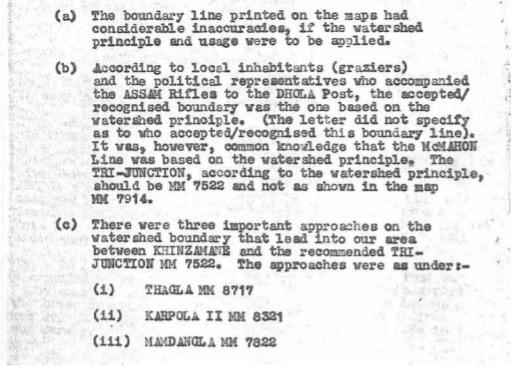
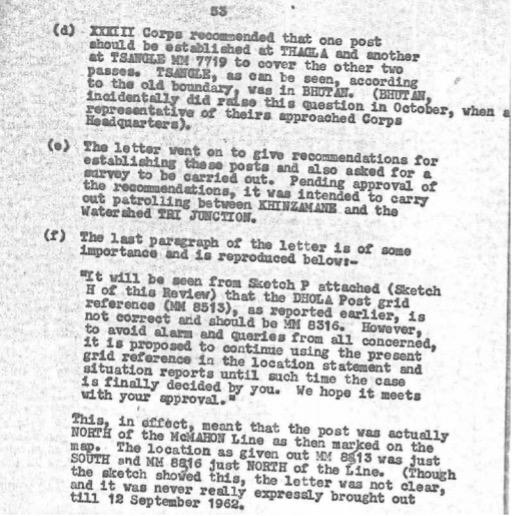
- Now comes the pièce de résistance. In the last paragraph of the letter. XXXIII Corps writes:
- “It will be seen from sketch that the Dho-la post grid reference MM8513, as reported earlier, is not correct and should be MM8316. However, to avoid alarm and queries from all concerned, it is proposed to continue using the present grid reference in the location statement and situation reports [emphasis ours] until such time the case is decided by you.”
[Note: Although the fact of the Dho-la post being located beyond the McMohan Line was known clearly to the corps, the letter obfuscates the fact. It does not clearly mention such a major and critical transgression, in so many words. In fact, this important issue was never expressly brought up till the Chinese came and surrounded the post on 8 September.]
[Note: Readers should be made aware, in this context, that XXXIII Corps vide their letter of February 24, 1962, had specifically recommended the setting up of the post (west of Khinzemane) at the trijunction, southeast of Tsangle (grid ref: MM7914) where the McMahon Line starts as per the original map, depicting the Line going west, atop the Tsangdhar ridge.]
The documents and conversations on record show, as above, that:
- Prasad, as patrol leader of 1 Sikh, first violated the McMahon Line in setting up the Dho-la post in June 1962. According to him, that was the area where he had been ordered to set up the post, as per his sand-model briefing.
- Parshad, GOC of 4 Division, responsible for the Kameng Frontier Division, was canvassing for further infringements of the McMahon Line, by moving even further north into the Thag La ridge
- Nathawat, GOC of XXXIII Corps, despite knowing about this infringement, condoned it and continued with the misrepresentation deliberately.
Now, at this juncture, let us pause and ponder on these murky goings about a sensitive, and under the circumstances, explosive issue like the nation’s borders.
- India steadfastly claimed the McMahon Line to be its legitimate border with Tibet, as inherited from the British Raj, legitimately, as per international law.
- The Chinese side was raising fundamental disputes on this “inheritance” both in the Nefa and Ladakh, calling it an unjust “colonial-imperial legacy”. They were in fact claiming entire Nefa (90,000 square kilometres)
- Therefore, it was not in India’s interest to discredit the McMahon Line in that volatile situation where China was looking for excuses to teach Nehru a lesson. That would be, aiding the Chinese design.
- These intricate political and legal matters are in the purview of the government and its specialized wings. Military officers at the unit and formation levels are neither qualified nor authorized to initiate material alterations to international boundaries through “fait accompli” actions.
- It was in the interest of the Chinese to dilute the legality and primacy of the McMahon Line through whataboutery and by ferreting out technical nuances.
- The local military commands’ raising of the “watershed line” issue and precipitately acting on it without prior approval of the government was completely out of line. Therefore, it not just gift-wrapped an excuse for aggression to the Chinese (who had already made up their minds to go on the offensive long back[R11], but also presented a fait accompli to the government. When the Chinese came and surrounded the Dho-la post on September 8, the government was presented with a Hobson’s choice. Neither could Nehru afford to be seen, by his domestic audience to be backing off in the face of aggression, nor could he allow the Chinese to think that India had feet of clay, when the chips were down.
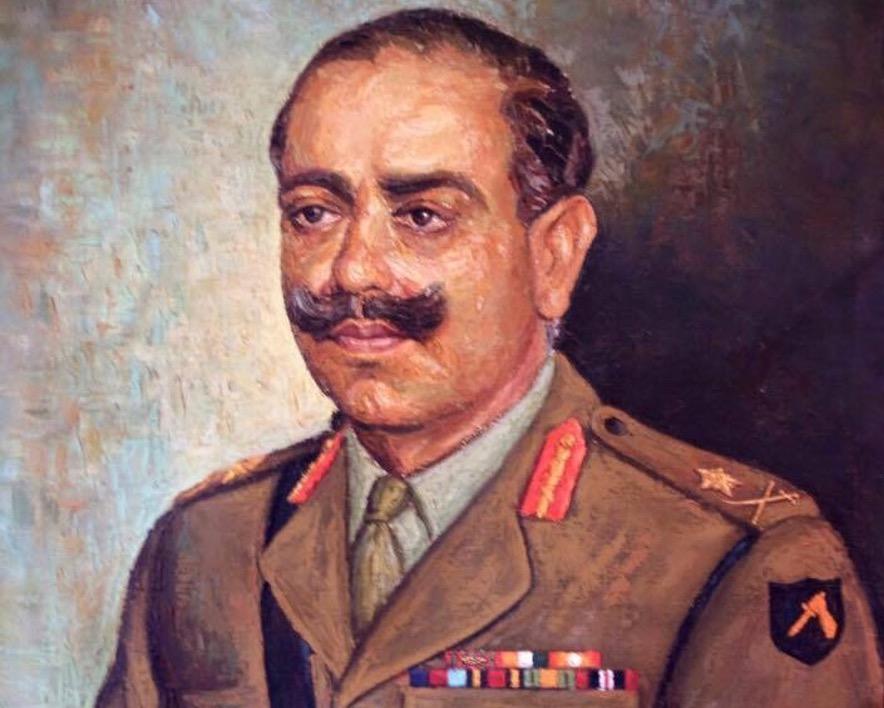 Portrait of Lt Gen Kunwar Umrao Singh Nathawat.
Portrait of Lt Gen Kunwar Umrao Singh Nathawat.
What we have said above, of course, does not absolve higher echelons from their despicable indecision and leadership failure. Three months after the Thag-la opportunity was missed by local commands and the infringement of the McMahon Line (Dho-la post) happened with a casual air, Eastern Army Commander got into the act. On November 13, 1962, Sen, Eastern Army GOC-in-C, held a meeting at Tezpur with Nathawat, GOC XXXIII Corps, and Parshad, GOC 4 Division, among others.
With a straight face, he said that the Indian government had always considered the watershed principle as the basis for the correct alignment of the McMahon Line.
[Note: Sen had come to Tezpur via Delhi, where he attended a meeting on October 12, chaired by Menon, the defence minister. What are the odds that his sudden enthusiasm for the watershed principle, was born out of some reassurance he had received from that exalted company in Delhi? It is immensely unfortunate and irregular as a procedure that Menon had insisted that no minutes would be kept of his meetings, purportedly of their sensitive nature. So, very conveniently for some, evidence of all moronic wrongdoings and blunders are buried forever in the maze of “I said-he said”.]
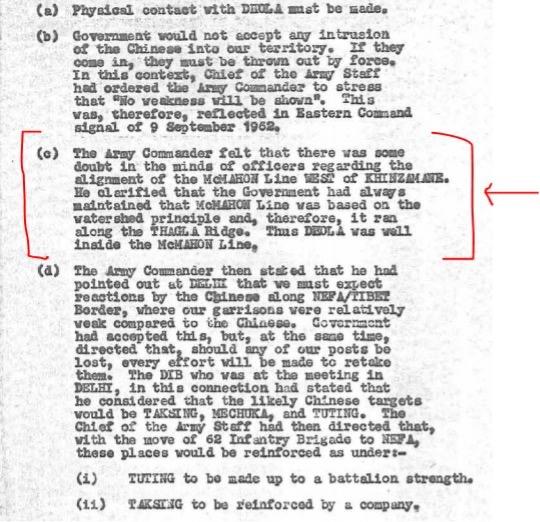
But true to our approach for this story, of sticking to documented evidence and first-person accounts only, it stands to reason that Sen had no clarity about any realignment of the McMahon Line (vis-à-vis the original line on the map) prior to this date.
As records suggest, his earlier studied silence on all clarifications sought by local formations, bear testimony to this. What is particularly painful, is the leadership failure.
A genuine lack of certainty about the McMahon Line, under those chaotic circumstances, is understandable. What is galling is the attempt to palm off the blame to lower formations by saying “there are some doubts in the minds of officers regarding the alignment of the McMahon Line west of Khinzemane”.
If Sen took responsibility for the earlier confusion in June, about the alignment of the McMahon Line, he would then also have had to take responsibility for the consequences of not occupying Thag-la in time. As a military man he would then not be able to disregard the tactical implications of hostile occupation of Thag-la so coolly when he thundered “they must be thrown out by force” (please see the image above from the Henderson Brooks report).
Thus, we can clearly see that India erred both politically and militarily in its defence of the McMahon Line in Nefa’s Namka-chu area.
Many commentators and a large section of Indians believe that the military should be “unshackled” and allowed to play a larger, more decisive, role in geostrategic decision-making. That constituency would perhaps feel differently about the conclusions arrived at in this fact-finding longread.
[Note: There are historical instances demonstrating the consequences of military-dictated, precipitate action in international relations, particularly in explosive situations[R13].]
Having said that the Indian Army was at fault militarily in Nefa, let us take our readers to a closer examination of all the options, the Army had in Kameng Frontier Division, on the ground, that fateful summer and autumn of 1962. In geostrategic policymaking, there is a school of thought that endorses pre-emptive military action in “national interest”, even if these are legally and morally questionable legally and morally.
Israel has been a consistent practitioner of this doctrine. They have often broken international law and transgressed considerations of morality, to protect their “national interests”.
Here we are not including mega events like the illegal US war against Iraq in 2004 or the Soviet Union’s imperialistic aggression against Afghanistan in 1979. We are limiting ourselves to pre-emptive occupation of foreign territory, adjoining one’s borders, for proactively protecting the nation’s vital interests – something like Israel’s operations inside Lebanon’s southern borders, in order to protect northern Israeli territory from militant and rocket attacks.
In the long run, these Israeli operations came to a dead end and had to be wound down. But they had met limited goals in the short term, for some years. Could the Army try anything like that in Nefa in 1962 in “national interest”?
The agitated reaction to this query would be one of incredulity and indignation. There is no comparison between the balance of military power that Israel had with Hezbollah in Lebanon and what India had with China at any stage.
But then what went into the thinking when the XXXIII Corps, 4 Division and their officers took liberties across the McMahon Line, casually and tried to drive these legal factors under the carpet? And, if they took those liberties in the national interest, one would assume that they were trying to protect India’s strategic, operational, and political interests in those circumstances of uncertainty?
As things turned out, India was prepared to deploy a brigade on and around the McMahon Line with artillery support. Prasad’s warning about the unsustainability of an FDL at Thag-la, presumed company level resources stretching across that entire theatre. However, since four battalions were available to be deployed in that immediate area, then both Karpo-la II and Namdang-la could have been covered to protect the flanks of any FDL on the Thag-la?
In that case why didn’t they occupy the Thag-la Ridge which tactically dominated the entire Namka-chu valley, between the India-Bhutan-Tibet trijunction and the Namka-chu (river)-Niyamjang-chu (river) confluence? The Hathung-la ridge to the south of the confluence was, after all, firmly in Indian control and dominated the Niyamjang-chu valley to the north. For decades, commentators have speculated that occupation of the Thag-la ridge would have given the Indian post command of both these valleys – and the Sumdorong-chu valley further east.
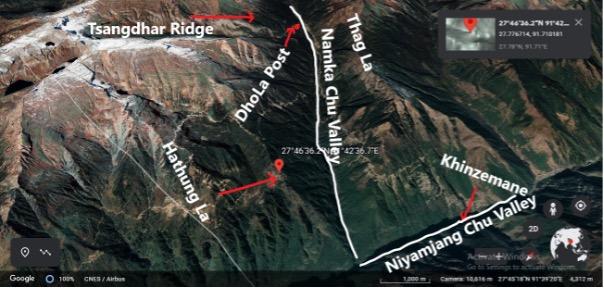
In the “what if” scenario, even though Prasad didn’t occupy Thag-la based on his perspective in May-June 1962, what stopped 7 Brigade or 4 Division from ordering it, once Prasad returned and made his report?
The Thag-la heights remained free of the PLA for many weeks after Prasad’s return. Niranjan Parshad’s griping to Kaul in October, over Thag-la made no sense at all since by setting up the post at Tse-dong (Dho-la post), the McMahon Line on the map had anyway been transgressed. So, what was this squeamishness about going in a bit deeper, and climbing the next height (nine more miles on the ground)?
If the Army sat atop the Thag-la ridge and its adjoining passes, legally or not, would then the subsequent “outflanking, infiltration and envelopment” manoeuvre that the PLA used against 7 Brigade on October 20, have been possible?
We have seen that most military narratives on the Namka-chu debacle, have held that as what made the fatal difference.
To reiterate our proposition:
Remember, the AHQ had permitted setting up of posts on the McMahon Line without prior sanction, vide their April 27 Memo.
We haven’t been able to find any credible or rational answers to this. The local commanders all blame the AHQ and the Eastern Army for not responding to their queries about the occupation of Thag-la, while there was time. However, none explain why the AHQ’s concurrence became vital for Thag-la but not for transgressing the McMahon Line beyond Tsangdhar, and setting up the Dho-la post.
If they could do it at Dho-la why not at Thag-la?
As we concluded earlier, we can now reiterate it and say that the Army’s command failure was without any rational reason on both political and military considerations.
Then, was it really Thag-la that made the difference on 20 October 1962?
Enough time and words have been spent on the tactical disadvantages of the Dho-la post, the vulnerability of the Namka-chu “shooting gallery” and the Thag-la lament. However, on the day of action, how decisive were these factors? On that morning of October 20, 1962, were these factors responsible for the decimation of unit after unit in the Namka-chu valley, in the Dho-la post, and up on the Tsangdhar ridge?
Or is it part of the larger myth-making that surrounds the Namka-chu debacle?
Let us step back a minute, from this exclusive focus on the Indian side of the story. Let us see what 7 Brigade was up against, on the Chinese side.
What were the PLA’s plans, their strength on the ground, what tactics they followed and how the viewed the Indian combat performance? This may show us a mirror on our brigade- and unit-level tactical performance.
***
Was the Indian army tactically sound and effective? Was the bravery and sacrifice of the Indian troops backed up by sound defensive plans, leadership, and tactics from their commanders?
We are quoting below a not-so-good translation of an interview of Lieutenant General Yin Fa Tang, who in 1962 served as the political commissar of PLA’s “Tibetan Army, Formation 419”.
Interview published in the second issue of the “Military History” magazine of the Academy of Military Sciences, China, in 2005.
The interviewer is Colonel Wei Bihai, deputy director, PLA’s History Research Office. We have spared readers the Chinese political narrative that inevitably colours such pieces in a totalitarian country and just presented the military, operational, and tactical aspects of the interview:
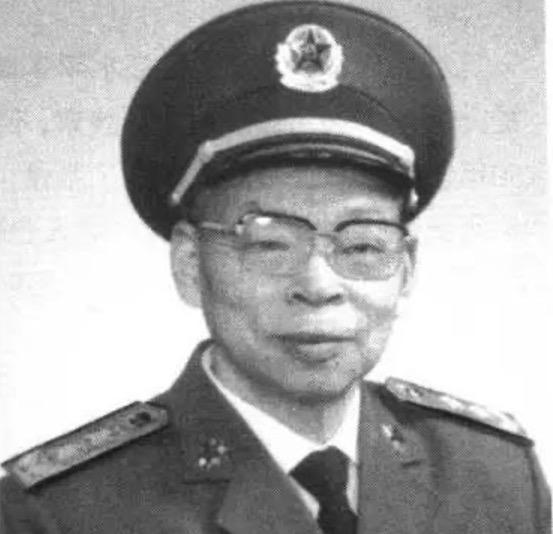 PLA Lt Gen Yin Fa Tang.
PLA Lt Gen Yin Fa Tang.
Wei Bihai: You are “Old Tibet”. From the Battle of Qamdo in 1950 to 1985, six years after reform and opening up, Tibet experienced tremendous changes and many major historical events with far-reaching influence. You have all experienced them. As a history researcher, I have too many questions to ask you. In view of the time limit, this time I will talk about one question-the formation of Tibetan 419 Troops.
Yin Fa Tang: The “Tibetan 419 Unit” was not originally a unit but the code name of a command headquarters called the “Advance Command of the Tibet Military Region”. This headquarters was formed in June 1962. At that time, the Tibet Military Region had only three regiments in the field. 419 commanded these three regiments to prepare for the armed conflict on the Sino-Indian border. Later, the command headquarters and its troops took part in the Sino-Indian border self-defence counterattack as troops equivalent to a division. By June 1963, the code name “Tibetan Unit 419” was cancelled, and it had existed for about a year. It can be said that the “Tibetan Unit 419” was formed temporarily to cope with the escalating armed conflict on the Sino-Indian border.
Wei: I heard that before the Battle of Kejielang (Chinese name for the Namka-chu area), the commander of Unit 419, especially you, gave very good suggestions on the decision-making of the battle. Please talk about the situation in this regard.
Yin: The frontline commanders should not mechanically execute orders from their superiors. They should follow the spirit of the Gutian Conference, put forward their own opinions based on the actual situation, and have the courage to make comments. This is also the old tradition of our People’s Liberation Army, especially the 18th Army. As mentioned earlier, Commander Zhang Guohua’s suggestions for changes to the general staff’s combat plan is a shining example.
At that time, the Indian 7th Brigade’s deployment in the Khjielang (Namka-chu) area was like a short-legged “T”. The front was wide, with shallow depth, and each stronghold was close to each other. If one of their battalions was annihilated, it is possible for the others to escape. Since we had the ability to destroy them, it is better to make a plan to wipe out the entire brigade. Fighting a brigade is a fight and fighting a battalion is also a fight. Fighting piecemeal actions against their battalions is more troublesome. It is better to fight a brigade with full intensity.
In fact, in this battle, commanders at all levels had put forward very good suggestions. For example, the military area pointed out that the original task given to the 155th Regiment of the main attacking force was to first annihilate the enemies of the Kalong stronghold (between Bridge IV and Bridge VI), and then to wipe out the enemies gun positions (artillery and heavy mortars on the Tsangdhar ridge) and other strongholds. In the 155th Regiment area, since Kalong is very close to the gun positions, the assault group must be accompanied by forces outflanking the enemy’s line (across the log bridge and area to its west) to attack their gun positions (on Tsangdhar ridge). They believed that they were capable of destroying these two strongholds at the same time, so they took the initiative to advise their superiors.
Chai Hongquan and Shi Banqiao (previously referred to as the deputy chief of staff of the military region) went to the 155th Regiment for inspection. The head of regiment Liu Guangtong and political commissar Qiao Xueting made this proposal to them. Chai and Shi did not agree. Later, I went to the 155 Unit and they suggested to me that my thinking makes sense and can be adopted. I asked Chai Hongquan that Chai didn't make a statement. He asked Shi Banqiao, Shi was not easy to say. I will report directly to Commander Zhang Guohua. Commander Zhang took it very seriously and called me directly to ask me, is it sure that the two strongholds will fight together? I have a better understanding of the situation of this unit, so I replied that there is no problem and I am sure. Commander Zhang decisively made the decision and approved the proposal of the 155 regiment. There are such cases.
Our participating forces were all the 419 Unit troops, the 2nd Battalion of the 32nd Regiment of the 11th Division, the 1st Shannan Army Division and one artillery and one engineering unit, which was a total of 10,300 (soldiers). Our strength ration with the enemy was 3:1 – we are three times the enemy. Commander Zhang Guohua authorized the 419 Unit command organization to command the abovementioned participating units. The front finger of the Tibet Military Region was in Ma Ma, and the 419 Command office was in Xuebo Cave.
Wei: Please talk about the history of the Battle of Kejielang (Namka-chu).
Yin: The Battle of Kejielang (Namka-chu) was the first battle in the Sino-Indian border self-defence counterattack, and it was also the fiercest and most difficult battle. Before the war, commanders at all levels carried out repeated reconnaissance of the enemy’s situation and terrain, studied and formulated very detailed combat plans based on actual conditions. After the Indian Army launched continuous attacks on us, we launched a self-defence counterattack in the early morning of October 20th. Our army adopts the tactics of night and dawn attacks, infiltrated under the cover of night, penetrated the enemy’s flanks and rear areas, and waited in hiding at the starting points of the attack.
The task of attacking the right wing of the Indian Army (Khinzemane post and the Niyamjang-chu valley route) was basically performed by the 154 Regiment alone. The 155 Regiment attacked the left-wing Karon (Bridge IV to the log bridge) and the gun positions of the Indian Army (on the Tsangdhar ridge) with the cooperation of the 157 regiment (they went across west of the log bridge) … a battalion of the 32nd Regiment of the 11th Division and the Shannan Army Division, launched an attack on the two positions of the Indian Army at 7.30 (?) in the morning.
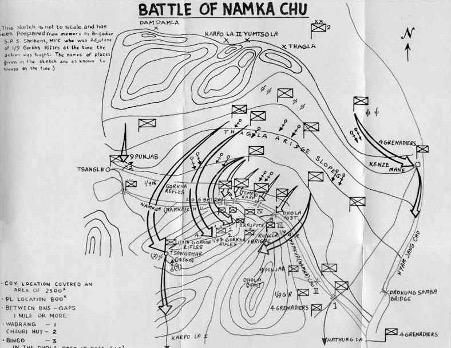 Sketch made by Brig SPS Shrikant MVC, then Adjutant 1/9 GR.
Sketch made by Brig SPS Shrikant MVC, then Adjutant 1/9 GR.
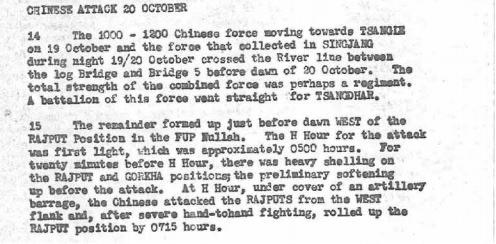
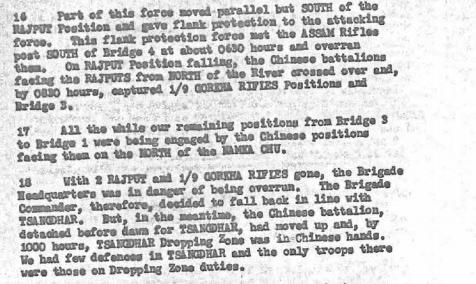 From Henderson Brooks Report.
From Henderson Brooks Report.
To be honest, the Indian Army was still very capable of fighting. They were the elite of the Indian Army, and they were deceived by propaganda, thinking that our army had invaded Indian territory, and they didn’t understand our army’s particularly brave fighting style and POW (prisoner of war) policy, so they just resisted blindly and defended the bunkers.
They suffered more deaths than the number of prisoners taken by us. For example, there were 143 Indian soldiers in the Kalong stronghold, of which 92 were killed by our army, and only 51 were taken prisoners, many of whom were captured because of injuries. Our army suffered more casualties in the battle to conquer Caron, sacrificed 21 people and wounded 29 people.
Wei: When the two strong meet, the brave wins [Sic]. It should be said that the tenacity of our army overwhelmed the Indian army.
Yin: That’s pretty good. The fortifications of the Indian Army were mainly bunkers. For example, in the Karon stronghold, with 143 Indian soldiers, 64 bunkers were built. Our army was attacking point by point from bunker to bunker. That’s really short-handed. The famous “Yangtingan Class” emerged during this battle. The squad had a total of eight people. The squad leader died, and the second squad leader went on to command; the second squad leader died, and the deputy squad leader immediately went up; the deputy squad leader died, and the veterans immediately went up, and finally sacrificed 7 people, leaving only one recruit. This recruit took the initiative to join another squad to continue fighting, really going forward. With the cooperation of another squad, this squad conquered 27 bunkers and wiped out 55 enemies. After the war, it was awarded the honorary title by the (Chinese) national defence ministry.
Where has the Indian Army seen such a powerful unit? We really overwhelmed them in momentum. Our army completed the three-day tough task, which was originally scheduled, in just one day. Most of the 7th Brigade of the Indian Army was annihilated at that time, and the rest was scattered in the jungle. Soon after, we cleared it out, and finally the entire brigade was annihilated. In the following battles, the morale of the Indian Army was completely disintegrated, and their army was really devastated.
***
Somewhere in the din of macrolevel issues of maps, memos, policies, and politics we lose sight of what actually happened on the ground, on the day of reckoning. The above Chinese account matches the version laid out by several military analysts and researchers from the Indian side. But the distinct advantage of reading the Chinese account is to see the battle without the background filters.
When you read Indian accounts, by the time you arrive at the actual battle on October 20, 1962, you are already heavily weighed down by factors like the domination of the PLA positions on the Thag-la ridge and the shortage of ammunition and supplies. But in the actual event, which factor(s) turned out to be decisive?
From a classical military doctrinal perspective, it is a no-brainer that if the enemy occupies higher terrain facing your positions and you are short of supplies, you will lose, unless help arrives. But is that what happened on the morning of the October 20? What difference would it have made if the Indian troops had ammunition and enough food? How did the Thag-la advantage eventually play out in the Chinese plan of attack and its execution?
For our general readers let us simplify what happened.
The Chinese 155 Regiment plus some troops from the 157 infiltrated at night, between the Indian positions on the left. They reached vantage points behind 2 Rajput’s positions and waited for “H-Hour” – the time of day at which an attack, landing, or other military operation is scheduled to begin. Other troops from the 157 Regiment came across the low flowing river on the left, through 1/9 GR positions and came towards the Tsangdhar heights, where our artillery and heavy mortars were deployed, along with our air-resupply zones.
After a brief bombardment in the morning, their troops were in and among our positions willy-nilly. The fighting was at close quarters and very soon it was a vicious hand-to-hand fight to the finish.
The Chinese account explicitly mentions, somewhat in awe, the dogged and suicidal nature of the Indian resistance, in these hopeless last-ditch actions!
In the meantime, the Chinese 154 Regiment rolled up our positions on the right, from the direction of the Niyamjang-chu valley. Similar outflanking manoeuvre, putting their troops behind our positions.
[Note: The lack of reserves behind the Indian FDL for local interception and counterattacks at the unit level as well as at the brigade level.]
When we read the Indian narratives, we get overwhelmed by the plethora of problems cited. But do we ask the basic tactical questions? We are told that the 7 Brigade was hamstrung by the insane order to attack Thag-la and its units were therefore strung out in untenable positions.
However, we have seen earlier here that Kaul had cancelled that order before he left the area on October 11 morning. He had ordered a defensive deployment. The same revised order was confirmed at the highest levels of the government and the army by the night of October 11.
So, in the intervening 10 days before the Chinese attack on the October 20, Dalvi was free to organise his defences. Or are we missing something here?
The missing links are provided by the HBR as under:
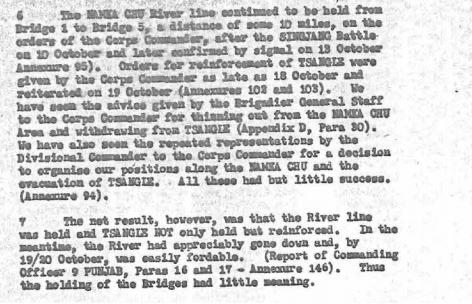
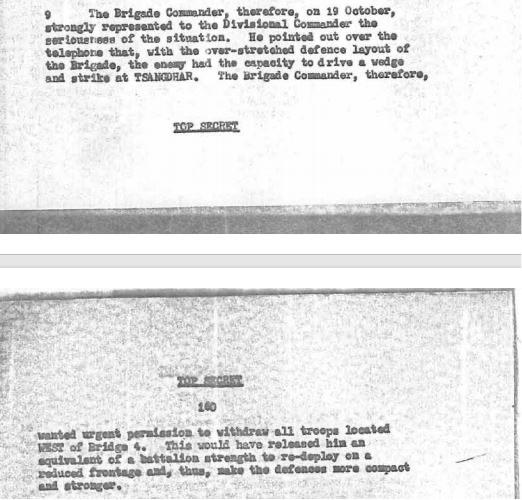
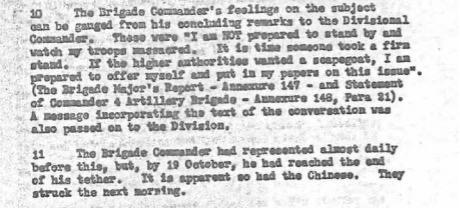
So, does it seem that Kaul and the AHQ had “hardened” their stance after their October 11 meltdown? The matter gets murky as well as quirky at this point.
Kaul had himself seen what was going on and particularly the state of supplies and logistics. He saw that basic covering fire to the D Company contingent of 9 Punjab, couldn’t be provided, when they were bravely battling it out at Tseng Jong. Nehru had given a free hand to Thapar and Sen. What changed after that?
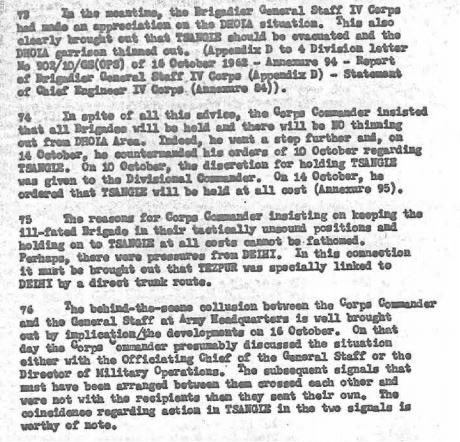
Did the apparent sanity that had returned on November 11 had evaporated in three days? Let’s see what indicators can be found in the HBR analyses.
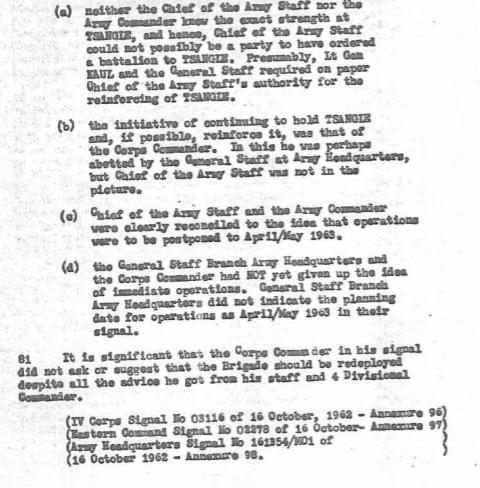
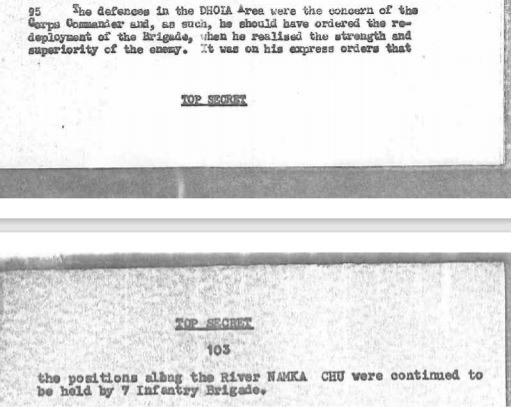

Here, it seems that the earlier intransigence of Thapar and Sen during Kaul’s briefing in Delhi, had been replaced by pragmatism in the next few days, while Kaul had relapsed into his “Wild West” ways?
But then, Kaul has gone on record saying that this was not his own stance, but his superiors prevailed upon him, against his express advice to the contrary. Take a look:
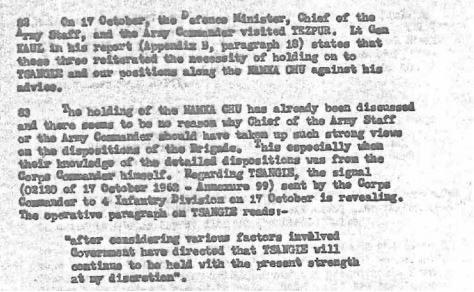
So, was Kaul lying – on record? Someone was lying here for sure. Was Krishna Menon whispering in his protégé’s ears even at this late date when the crisis was reaching a crescendo? We have seen earlier here that Menon had forbidden the keeping of records and minutes of his meetings. But then what kept Thapar and Sen from stepping in?
Though the Henderson Brookes Report implies and surmises that all the blame lay at the door of Kaul, do the documented facts revealed this far, absolve the other two officers? During the meeting with Nehru on the evening of October 11, did not the chief of the Army staff, Thapar, and GOC-in-C Eastern Army, Sen, shoot down Kaul’s proposal to relocate the brigade?
We don’t really see any evidence here to believe that these two officers were not party to this disgraceful command failure.
In our off-the-record discussions with military commanders at the highest levels, we have tried to understand what could have possibly deterred Parshad and Dalvi from reorienting their defences at the Namka-chu theatre in the week they had, after Kaul’s order to go on the defensive.
“Holding the bridges” on Namka-chu can be interpreted as denying their usage by the enemy. The river by now was a shallow stream, with the water level having come down substantially. Now the bridges were anyway not obstacles to the PLA crossing over anymore. India had artillery and heavy mortars on Tsangdhar. MMGs would be covering the bridges and the other side of the river. Why was it essential to hold on to that “T-shaped” deployment with no depth and no reserves, for interception and counter attacks?
How could the Chinese 155 and 157 regiments infiltrate so easily and successfully? They infiltrated in strength, penetrated to the rear, and got in among the Indian positions. Commanding heights of Thag-la or shortage of supplies have nothing to do with this monumental blunder in defence. And no, higher commands didn’t not hand down this defensive plan per se.
It is true that the local command had been denied the prerogative of “thinning down” the defences by the river. But did that construe the dictating of actual field deployment of units and companies?
We have been advised by “thinking” and conscientious, senior commanders, that under the dire circumstances that Parshad and Dalvi found themselves, they could have interpreted their orders liberally and redeployed their defences, while covering the river. After all an insane deployment of resources in the FDL of a brigade, can’t really be part of a valid order given by a two-level higher command, can it[F3]?
Commanders, down the ages, have followed this dictum, when responding to the immediate situation on the ground.
When Chinese troop movements towards forward staging areas (see HBR image below) were clearly visible on October 19, their intentions towards an imminent offensive were clear.

Dalvi claims to have known that his line abreast dispositions would be penetrated and overwhelmed easily. Strangely, even after surmising that the PLA may be aiming for penetrating his left flank to have a go for his artillery and supply base on Tsangdhar, he didn’t detail any troops to watch over the likely ingress routes across the river and its south bank.
This collective obsession with Tsangle is amazing!
The PLA were swarming all over the Thag-la ridge line and the passes on it. The Army had given up all hopes of an offensive up to that ridge line. So, what was now the tactical criticality of Tsangle?
So, we can see, Dalvi and his boss, Parshad watched all this happening. Griped and argued but did nothing.
What were they waiting for? Where was their professional military man’s conscience and sense of accountability to their men and task a hand? There are plenty of instances in military history[F4] where local commanders or juniors in positions where they could make a difference, have liberally interpreted their orders, when compelling circumstances so demanded, on the ground.
Seeing Parshad’s later conduct under fire, in the next war (September 6–7, 1965, as GOC of 15 Division on Wagah-Lahore axis). it can be safely said that the man didn’t have what it takes to command troops in action[F5].
The job of a commander is to meet the objective of an operation and look after his men and equipment in the process. Can a commander plead helplessness later while interpreting his orders literally and knowingly courting disaster? Whether that would have materially changed the outcome is another matter, but a better fight may have been given.
Defeat need not have been so quick, comprehensive and humiliating.
As a sad footnote to this story, we must add that while the careers and reputations of the top brass like Kaul may have had to “lie down on the beds they, themselves, made”, they did live on to write their memoirs and ruminate on what could have been.
But one officer literally did lie down on the bed of his own making. The fall guy – Capt Mahabir Prasad had been deputed to 1/9 GR from his original unit (1 Sikh). By a cruel stroke of fate, he ended up defending a position on October 20, which, in his original assessment, was “suicidal”. Just as he had predicted in June that year, the Dho-la post and our defences around it were infiltrated and penetrated in no time.
The Calcutta boy, Prasad, didn’t live to tell his tale or reveal the complete reality of Namka-chu, which was cremated along with his body. He fell fighting that morning, among the dense foliage and on the soggy ground, he had patrolled so extensively just four months ago.
As was the fate of so many of his brother officers and their men, who, according to the Chinese account above, fell where they stood, rather than surrender. The senior officers lived on to tell their tales, the incomplete stories tailored to make themselves look good. Like Prasad’s uncle, Maj Gen Niranjan Parshad, commander of 4 Division, and his brigade commander Brig John Dalvi and the oh-so-innocent Lt Gen Kaul.
It is important that the complete truth about these wars, in which people die, are known and analysed. More than celebrating the victories, it is critical to understand the reversals and then act on such understanding. Otherwise, we will have a never-ending caravan of Namka-chu (1962) and IPKF (1987–1990) and Kargil (1999) and Galwan (2020) … and the perpetual bloodletting in Kashmir’s counterinsurgency operations.
“The entire deaths of Vietnam died in vain. And they’re dying in vain right this very second. And you know what’s worse than a soldier dying in vain? It’s more soldiers dying in vain. That’s what’s worse.” – Mike Gravel
Mentions:
[M1] “The Himalayan Blunder” by Brigadier John Dalvi.
[M2] “The Battle of Tawang” by Maj Gen KK Tiwari.
[M3] “1962 War: Battle of Namka Chu – As I Saw It” by Brigadier AJS Behl.
References:
[R1] “New Directions in the Study of China’s Foreign Policy – China’s Decision for War with India in 1962” by John W Garver.
[R2] “China’s Policy of Conciliation and Reduction and its Impact on Boundary Negotiations and Settlements in the Early 1960s” by Eric Hyer.“
[R3] The CIA’s Secret War in Tibet” by Kenneth Conboy and James Morrison.
[R4] “India and the China Crisis” by Steven A Hoffmann.
[R5] Chinese sources used, have been mentioned in text, at the relevant places.
[R6] Based on sources who, on the condition of anonymity, revealed to us about Capt Mahabir Prasad’s observations and views on the Namka-chu area and the Dho-la post.
[R7] “History of the Conflict with China, 1962” by Dr PB Sinha and Colonel AA Athale.
[R8] “The Untold Story” by Lt Gen Brij Mohan Kaul
[R9] “The Henderson Brooks Report” that was “leaked” by Neville Maxwell.
[Note 1: We have deliberately left out Neville Maxwell’s analysis and perspective from India’s China war, in toto. His role and doings in India as the South Asian correspondent of The Times were curious to say the least. He had disgraced himself as an analyst and scholar of any consequence, when he predicted that the 1967 parliamentary election would be India’s last democratic election and the country’s democracy would collapse after that. Moreover, while he made full use of the relatively free ambience in India, to the extent of acquiring a copy of the, then classified and unobtainable, Henderson Brooks Report on the India-China war, he had absolutely no independent insight into the Chinese side of things, apart from official communiques and biased private briefings. Therefore, we consider his work as an incomplete treatise, prejudiced and blind to one set of facts – the facts from China’s side. However, we have used Maxwell’s “leaked” copy of the Henderson Brooks Report for much of our referencing on the Indian Army’s decisions, orders, reports, and opinions, apart from other sources for first-hand reports, from participants like Lt Gen BM Kaul’s – “The Untold Story” and Brig John Dalvi’s “The Himalayan Blunder”. We consider his copy of the HBR authentic since the Indian government immediately banned his book – “India’s China War” – in 1970 because it quoted the HBR and declared him a proclaimed offender under the Official Secrets Act. This indirectly confirms that his copy of the HBR was genuine.]
[Note:2 The Morarji Desai government withdrew the charges in 1978. Hence, the criminalization of the event has long been rendered null and void. With the recent publication of the HBR in Maxwell’s website and numerous copies circulated on the internet, the matter of the OSA violation is now dead.]
[R10] From Kenneth Conboy and James Morrison’s “The CIA’s Secret War in Tibet”: “Indian spymaster Mullik (BN) quietly reaffirmed his tacit approval of the agency’s (CIA’s) efforts in 1961 and had earlier claimed that Nehru held similar beliefs.”
[R11] From Wu Lengxi’s book – “Shi nian lunzhan, 1956–1966, Zhong Su guanxi huiyilu” (Ten-Year War of Words, 1956–1966, a Memoir of Sino-Soviet Relations) – that said: “According to Chairman Mao, India was at fault and was instigating the Tibetan rebellion. He directed that India wouldn’t be confronted at that moment but would be taught a lesson later, after India further aggravated the situation through her own doings.”
[R12] Since the India-China border dispute is historically linked to “differing perceptions”, it is important to note that in Nefa, the McMahon Line is a clearly drawn boundary, whose wisdom and methodology may be disputed on technical grounds, but not its location on the map. The Shimla Convention of 1914, between British India, Tibetan government, and its sovereign overlord – Republic of China, produced this boundary with clearly laid down coordinates. Subsequently the pre-communist Chinese government disputed that part of the agreement which dealt with the demarcation of the areas under the Tibetan government’s authority (the blue line) and those directly under Chinese administration. [This was the reason why Ivan Chen, the Chinese representative, didn’t sign the final agreement.] However, the part demarcating the India-Tibet border (the red line, which is also known as the McMahon Line) over 890 kilometres from the northeastern extremity of Bhutan to the Isu-Razi pass on the Burma (now Myanmar) border, remained undisputed between the respective signatories – Henry McMahon, foreign secretary of British India and Lonchen Satra, representative from the Tibetan government.
[R13] The Schlieffen Plan during World War I and the French coup d'états of 1958 and 1961.
Footnotes:
[F1] The “chief of Army staff or COAS” has been referred to as “Army chief” in subsequent mentions.
[F2] Captain Mahabir Prasad was the nephew of Major General Niranjan Parshad. While Captain Prasad has been referred to as “Prasad” in this article, it should not be confused with “Parshad”, which is used to refer to his uncle, Major General Niranjan Parshad.
[F3] “Thinning out” is a subjective term when applied to frontline conditions. “No plan of operations survives, with any certainty, beyond the first encounter with the enemy's main force” was Prussian war guru, Field Marshal Helmuth von Moltke’s sagely assertion in 1880 (Helmuth Graf von Moltke, Militarische Werke, Kriegsgechichtliche Einzelschriften).
[F4] A historical reference can be drawn from an incident during British General Claude Auchinleck’s Operation Crusader in North Africa, in 1941, when German General Erwin Rommel’s operations officer, Siegfried Westphal, on his own risk, against Rommel’s orders, recalled the 21 Panzer Division all the way back to the Tobruk front restoring a disastrous situation somewhat.
[F5] Western Army GOC-in-C Lieutenant General Harbaksh Singh, in his book – “In the line of duty” – described Parshad’s removal from command during a battle, in the early days of the India-Pakistani war of 1965, as: “We were directed by the divisional Military Police to the general officer commanding, Major General Niranjan Prasad, who was hiding in a recently irrigated sugarcane field. He came out to receive us, with his boots covered with wet mud. He had no headcover, nor was he wearing any badges of rank. He had stubble on his face, not having shaved, contrary to the custom before the start of an operation. Seeing him in such a state, the first question I asked him was whether he was the general officer commanding a (military) division or a coolie?”
Disclaimer: The views expressed in this article is the author’s own and may not reflect the views of India Sentinels.
© India Sentinels 2020–2021.
All rights reserved.


